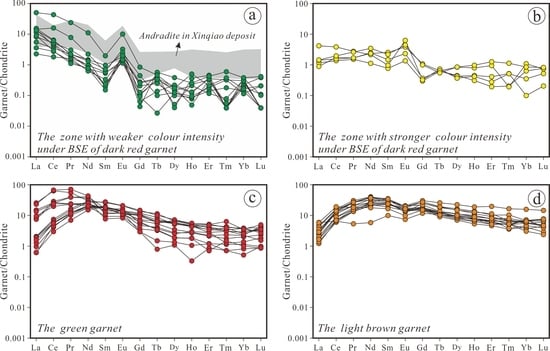Fingerprinting the Hydrothermal Fluid Characteristics from LA-ICP-MS Trace Element Geochemistry of Garnet in the Yongping Cu Deposit, SE China
Abstract
:1. Introduction
2. Geological Setting
2.1. Regional Geology
2.2. Ore Deposit Geology
3. Geology of the Yongping Garnet
4. Sampling and Analytical Methods
5. Results
5.1. Garnet Petrography
5.2. Major Element Geochemistry
5.3. Trace Element Geochemistry
5.4. Microthermometric Results from Fluid Inclusions
6. Discussion
6.1. Origin of the Yongping Garnet
6.2. Physicochemical Conditions of Hydrothermal Fluids for Garnet Growth
6.2.1. pH
6.2.2. Oxygen Fugacity
6.3. Metasomatic Dynamics of Yongping Garnet
6.4. Implications for Yongping Mineralization
7. Conclusions
- (1)
- The Yongping garnet generally resulted from a grossular–andradite solid solution, and range from nearly pure andradite Ad98 to Ad32Gr66.
- (2)
- The hydrothermal fluid that formed the Yongping garnet was under physicochemical conditions with temperatures of 387–477 °C, pressures of 44–64 MPa, mildly acidic pH levels, and unstable oxygen fugacity with enriched LREE.
- (3)
- The Yongping garnet may have resulted from hydrothermal replacement primarily by infiltration metasomatism.
- (4)
- The Yongping deposit represents stratiform skarn-type mineralization that is related with Jurassic magmatic-hydrothermal fluids associated with the Shizitou stock.
Acknowledgments
Author Contributions
Conflicts of Interest
References
- Meinert, L.D.; Dipple, G.M.; Nicolescu, S. World Skarn Deposits. Econ. Geol. 2005, 100, 299–336. [Google Scholar]
- Yardley, B.W.; Rochelle, C.A.; Barnicoat, A.C.; Lloyd, G.E. Oscillatory zoning in metamorphic minerals: An indicator of infiltration metasomatism. Mineral. Mag. 1991, 55, 357–365. [Google Scholar] [CrossRef]
- Jamtveit, B.; Wogelius, R.A.; Fraser, D.G. Zonation patterns of skarn garnets: Records of hydrothermal system evolution. Geology 1993, 21, 113–116. [Google Scholar] [CrossRef]
- Crowe, D.E.; Riciputi, L.R.; Bezenek, S.; Ignatiev, A. Oxygen isotope and trace element zoning in hydrothermal garnets: Windows into large-scale fluid flow behavior. Geology 2001, 29, 479–482. [Google Scholar] [CrossRef]
- Fernando, G.; Hauzenberger, C.A.; Baumgartner, L.P.; Hofmeister, W. Modeling of retrograde diffusion zoning in garnet: Evidence for slow cooling of granulites from the Highland Complex of Sri Lanka. Mineral. Petrol. 2003, 78, 53–71. [Google Scholar] [CrossRef]
- Smith, M.P.; Henderson, P.; Jeffries, T.E.R.; Long, J.; Williams, C.T. The rare earth elements and uranium in garnets from the Beinn and Dubhaich Aureole, Skye, Scotland, UK: Constraints on processes in a dynamic hydrothermal system. J. Petrol. 2004, 45, 457–484. [Google Scholar] [CrossRef]
- Kim, H.S. Deformation-induced garnet zoning. Gondwana Res. 2006, 10, 379–388. [Google Scholar] [CrossRef]
- Martin, L.A.J.; Ballèvre, M.; Boulvais, P.; Halfpenny, A.; Vanderhaeghe, O.; Duchêne, S.; Deloule, E. Garnet re-equilibration by coupled dissolution-reprecipitation: Evidence from textural, major element and oxygen isotope zoning of ‘cloudy’ garnet. J. Metamorph. Geol. 2011, 29, 21–231. [Google Scholar] [CrossRef]
- Scherer, E.E.; Cameron, K.L.; Blichert-Toft, J. Lu-Hf garnet geochronology: Closure temperature relative to the Sm-Nd system and the effects of tracemineral inclusions. Geochim. Cosmochim. Acta 2000, 64, 3413–3432. [Google Scholar] [CrossRef]
- Pertermann, M.; Hirschmann, M.M.; Hametner, K.; Günther, D.; Schmidt, M.W. Experimental determination of trace element partitioning between garnet and silica-rich liquid during anhydrous partial melting of MORB-like eclogite. Geochem. Geophys. Geosyst. 2004, 5, 297–319. [Google Scholar] [CrossRef]
- Gaspar, M.; Knaack, C.; Meinert, L.D.; Moretti, R. REE in skarn systems: A LA–ICP-MS study of garnets from the Crown Jewel gold deposit. Geochim. Cosmochim. Acta 2008, 72, 185–205. [Google Scholar] [CrossRef]
- Schmidt, A.; Mezger, K.; O’Brien, P.J. The time of eclogite formation in the ultrahigh pressure rocks of the Sulu terrane: Constraints from Lu–Hf garnet geochronology. Lithos 2011, 125, 743–756. [Google Scholar] [CrossRef]
- Cheng, H.; Zhang, C.; Vervoort, J.D.; Lu, H.H.; Wang, C.; Cao, D.D. Zircon U-Pb and garnet Lu-Hf geochronology of eclogites from the Lhasa Block, Tibet. Lithos 2012, 155, 341–359. [Google Scholar] [CrossRef]
- Somarin, A.K. Garnet composition as an indicator of Cu mineralization: Evidence from skarn deposits of NW Iran. J. Geochem. Explor. 2004, 81, 47–57. [Google Scholar] [CrossRef]
- Zhai, D.G.; Liu, J.J.; Zhang, H.Y.; Wang, J.P.; Su, L.; Yang, X.A.; Wu, S.H. Origin of oscillatory zoned garnets from the Xieertala Fe–Zn skarn deposit, northern China: In situ LA–ICP-MS evidence. Lithos 2014, 190, 279–291. [Google Scholar] [CrossRef]
- Gu, L.X.; Zaw, K.; Hu, W.X.; Zhang, K.J.; Ni, P.; He, J.X.; Xu, Y.T.; Lu, J.J.; Lin, C.M. Distinctive features of Late Paleozoic massive sulfide deposits in South China. Ore Geol. Rev. 2007, 31, 107–138. [Google Scholar] [CrossRef]
- Xu, Y.T. The characteristics of genetical geochemistry of cherts in Yongping copper deposit, Jiangxi Province. Geotecton. Metallog. 1996, 20, 20–28. (In Chinese) [Google Scholar]
- Li, X.H.; McCulloch, M.T. Secular variation in the Nd isotopic composition of Neoproterozoic sediments from the southern margin of the Yangtze block: Evidence for a Proterozoic continental collision in southeast China. Precambrian Res. 1996, 76, 67–76. [Google Scholar] [CrossRef]
- Liu, X.; Huang, Z. The discussion on the development of structures at Yongping Cu deposit in Jiangxi Province. Miner. Resour. Geol. 1991, 6, 416–422. (In Chinese) [Google Scholar]
- Lu, C.H. Ore Source and Mineralization of Molybdenum in Copper Deposit in Yongping, Jiangxi. J. East China Coll. Geol. 1986, 9, 116–127. (In Chinese) [Google Scholar]
- Chen, Y.F. The Metallogenic Material Source and Genesis of the Yongping Copper Deposit. Nonferrous Met. 2004, 56, 19–21. (In Chinese) [Google Scholar]
- Du, L.T. Sources of ore–forming material and genesis analysis of Yongping Copper Deposit, Jiangxi. Hubei Geol. Miner. Resour. 2005, 19, 4–11. (In Chinese) [Google Scholar]
- Luo, P. Metallogenetic Regularities and Prediction of Copper-Lead-Zinc-Silver Mineralization in the Area of Chenfang-Yongping, Yanshan County, Jiangxi Province. Master’s Thesis, China University of Geosciences, Wuhan, China, 2005. (In Chinese). [Google Scholar]
- Li, H.X. The Appraisal of Favorableness to Ore–Forming of Copper and Polymetallic Ore in Yongping of Jiangxi Province. Master’s Thesis, Hefei University of Technology, Hefei, China, 2009. (In Chinese). [Google Scholar]
- Cao, D.H. Internal Research Report: Metallogenetic Regularities of Shizitou Mo Deposit, Yongping, Jiangxi Province, China; Chinese Academy of Geological Sciences: Beijing, China, 2012. (In Chinese) [Google Scholar]
- Shao, Y.J.; Zhang, Y.; Quan, W.; Luo, M.Y. Internal Research Report: Deep Ore Prospecting for Yongping Cu Deposit, Jiangxi Province, China; Central South University: Changsha, China, 2015. (In Chinese) [Google Scholar]
- Zhu, X.T.; Ni, P.; Wang, G.G.; Cai, Y.T.; Chen, H.; Pan, J.Y. Fluid inclusion, H-O isotope and Pb-Pb age constraints on the genesis of the Yongping copper deposit, South China. J. Geochem. Explor. 2016. [Google Scholar] [CrossRef]
- He, J. Discussion on skarn genesis of Yongping copper deposit. J. Sichuan Inst. Build. Mater. 1989, 4, 31–40. (In Chinese) [Google Scholar]
- He, J. Metallogenic geochemistry and genesis study on Yongping copper ore deposit of Jiangxi Province. Miner. Resour. Geol. 1993, 7, 1–7. (In Chinese) [Google Scholar]
- Ding, X.; Jiang, S.Y.; Ni, P.; Gu, L.X.; Jiang, Y.H. Zircon SIMS U-Pb geochronology of host granitoids in Wushan and Yongping copper deposits, Jiangxi Province, China. Geol. J. China Univ. 2005, 11, 383–389. (In Chinese) [Google Scholar]
- Zhu, B.; Jiang, S.Y.; Ding, X.; Jiang, Y.H.; Ni, P.; Gu, L.X. Hydrothermal Alteration and Petrogenesis of Granites in the Yongping Copper Deposit, Jiangxi Province: Constraints from Mineral Chemistry, Element Geochemistry, and Sr–Nd–Hf Isotopes. Acta Petrol. Sin. 2008, 24, 1900–1916. (In Chinese) [Google Scholar]
- Mao, J.W.; Chen, M.H.; Yuan, S.D.; Guo, C.L. Geological Characteristics of the Qin-Hang (or Shihang) Metallogenic Belt in South China and Spatial-Temporal Distribution Regularity of Mineral Deposits. Acta Petrol. Sin. 2011, 85, 636–658. (In Chinese) [Google Scholar]
- Ren, J.G. Tectonic mineralization and genesis of Yongping copper deposit, Jiangxi Province. Copp. Eng. 1994, 3, 35–40. (In Chinese) [Google Scholar]
- Ren, J.G. The characteristics and genesis of molybdenum mineralization in Yongping. Copp. Eng. 1996, 3, 40–44. (In Chinese) [Google Scholar]
- Zhang, Z.S.; Zhu, M.Q. Geochemical Evidence of Sedimentary Exhalation Mineralization of Yongping Copper Deposits. Miner. Depos. 2002, 21, 545–547. (In Chinese) [Google Scholar]
- Liao, Z.T.; Liu, J.S. Evidence of submarine volcanic hydrothermal sediment mineralization in Yongping copper deposit. Copp. Eng. 2003, 1, 31–35. (In Chinese) [Google Scholar]
- Ni, P.; Tian, J.H.; Zhu, X.T.; Ling, H.F.; Jiang, S.Y.; Gu, L.X. Fluid inclusion studies on footwall stringer system mineralization of Yongping massive copper deposit, Jiangxi Province, China. Acta Petrol. Sin. 2005, 21, 1339–1346. (In Chinese) [Google Scholar]
- Tian, M.J.; Li, Y.G.; Wan, H.Z.; Zhang, Y.; Gao, T.T. Characteristics of skarn minerals in Yongping copper deposit, Jiangxi Province, and geological significances. Acta Petrol. Sin. 2014, 30, 3741–3758. (In Chinese) [Google Scholar]
- Luo, M.Y. Characteristics of the Ore–Forming Hydrothermal Fluid in Yongping Cu-Mo Ore Field, Jiangxi Province, Southern China. Master’s Thesis, Central South University, Changsha, China, 2016. (In Chinese). [Google Scholar]
- Einaudi, M.T.; Burt, D.M. Introduction-terminology, classification, and composition of skarn deposits. Econ. Geol. 1982, 77, 745–754. [Google Scholar] [CrossRef]
- Doyle, M.G.; Allen, R.L. Subsea-floor replacement in volcanic-hosted massive sulfide deposits. Ore Geol. Rev. 2003, 23, 183–222. [Google Scholar] [CrossRef]
- Zhang, X.S. Characteristics of Chemical Composition and Mineral Inclusions of Ore Minerals in Yongping Copper Deposit. Jiangxi Geol. 1997, 11, 40–48. (In Chinese) [Google Scholar]
- Tian, J.H.; Ni, P.; Fan, J.G. Ore–forming fluid characteristics research of Yongping copper deposit. Contrib. Mineral. Petrol. 2001, 16, 24–27. (In Chinese) [Google Scholar]
- Shui, T.; Xu, B.T.; Liang, R.H.; Qiu, Y.S. Paleo-continent building belt in Shaoxing-Jiangshan. Chin. Sci. Bull. 1986, 6, 444–448. (In Chinese) [Google Scholar]
- Wang, X.L.; Zhou, J.C.; Griffin, W.L.; Wang, R.C.; Qiu, H.S.; O’Reilly, S.Y.; Xu, X.S.; Liu, X.M.; Zhang, G.L. Detrital zircon geochronology of Precambrian basement sequences in the Jiangnan orogen: Dating the assembly of the Yangtze and Cathaysia Blocks. Precambrian Res. 2007, 159, 117–131. [Google Scholar] [CrossRef]
- Mao, J.W.; Cheng, Y.B.; Chen, M.H.; Pirajno, F. Major types and time-space distribution of Mesozoic ore deposits in South China and their geodynamic settings. Miner. Depos. 2013, 48, 267–294. [Google Scholar]
- Zhao, C.; Ni, P.; Wang, G.G.; Ding, J.Y.; Chen, H.; Zhao, K.D.; Cai, Y.T.; Xu, Y.F. Geology, fluid inclusion, and isotope constraints on ore genesis of the Neoproterozoic Jinshan orogenic gold deposit, South China. Geofluids 2013, 13, 506–527. [Google Scholar] [CrossRef]
- Zhou, X.M.; Sun, T.; Shen, W.Z.; Shu, L.S.; Niu, Y.L. Petrogenesis of Mesozoic granitoids and volcanic rocks in South China: A response to tectonic evolution. Episodes 2006, 29, 26–33. [Google Scholar]
- Wang, G.G.; Ni, P.; Yu, W.; Chen, H.; Jiang, L.L.; Li, P.F. Petrogenesis of Early Cretaceous post-collisional granitoids at Shapinggou, Dabie Orogen: Implications for crustal architecture and porphyry Mo mineralization. Lithos 2014, 184–187, 393–415. [Google Scholar] [CrossRef]
- Zhang, H.; Ling, M.M.; Liu, Y.L.; Tu, X.L.; Wang, F.Y.; Li, C.Y.; Liang, H.Y.; Yang, X.Y.; Arndt, N.T.; Sun, W.D. High oxygen fugacity and slab melting linked to Cu mineralization: Evidence from Dexing porphyry copper deposits, Southeastern China. J. Geol. 2013, 121, 289–305. [Google Scholar] [CrossRef]
- Wang, T.G.; Ni, P.; Wang, G.G.; Zhang, T. Identification and significance of methanerich fluid inclusions in changba Pb-Zn deposit, Gansu province. Acta Petrol. Sin. 2008, 24, 2105–2112. (In Chinese) [Google Scholar]
- Li, L.M.; Sun, M.; Wang, Y.; Xing, G.; Zhao, G.; He, Y.; He, K.; Zhang, A. U-Pb and Hf isotopic study of detrital zircons from the meta-sedimentary rocks in central Jiangxi Province, South China: Implications for the Neoproterozoic tectonic evolution of South China Block. J. Asian Earth Sci. 2011, 41, 44–55. [Google Scholar] [CrossRef]
- Li, L.M.; Sun, M.; Wang, Y.; Xing, G.; Zhao, G.; Lin, S.; Xia, X.; Chan, L.; Zhang, F.; Wong, J. U-Pb and Hf isotopic study of zircons from migmatised amphibolites in the Cathaysia Block: Implications for the early Paleozoic peak tectonothermal event in Southeastern China. Gondwana Res. 2011, 19, 191–201. [Google Scholar] [CrossRef]
- Qin, X.F. A Preliminary Framework for the Sequence of Volcanic-Intrusive Magma of Relation to Mineralization in the North Wuyi Yanshanian Area. Master’s Thesis, China University of Geosciences, Beijing, China, 2014. (In Chinese). [Google Scholar]
- Yu, D.; Ye, F.; Wang, Y. Active succession establishment for volcanic-intrusive complex in Middle-Late lower Cretaceous in Guangfeng, Jiangxi and its geological implication. Geotecton. Metallog. 2001, 25, 271–276. (In Chinese) [Google Scholar]
- Wang, G.G.; Ni, P.; Zhao, K.D.; Wang, X.L.; Liu, J.Q.; Jiang, S.Y.; Chen, H. Petrogenesis of the Middle Jurassic Yinshan volcanic-intrusive complex, SE China: Implications for tectonic evolution and Cu-Au mineralization. Lithos 2012, 150, 135–154. [Google Scholar] [CrossRef]
- Zhang, Z.H. Large-Scale Metauogenic Prognosis for Concealed Deposits in Northeastern Jiangxi; Geological Publishing House: Beijing, China, 1996. (In Chinese) [Google Scholar]
- Jiang, Y.H.; Zhao, P.; Zhou, Q.; Liao, S.Y.; Jin, G.D. Petrogenesis and tectonic implications of Early Cretaceous S- and A-type granites in the northwest of the Gan-Hang rift, SE China. Lithos 2011, 121, 55–73. [Google Scholar] [CrossRef]
- Quan, W. Petrogenesis of Shizitou Granites in Yongping Cu-Mo deposit, Jiangxi Province. Master’s Thesis, Central South University, Changsha, China, 2015. (In Chinese). [Google Scholar]
- Luo, P. Research on Metallogenic Regularities and Prospecting Orientation of Copper Polymetal Mineral Resources in the Northern Wuyi Region of Jiangxi Province. Ph.D. Thesis, China university of Geosciences, Beijing, China, 2010. (In Chinese). [Google Scholar]
- Liu, Y.S.; Gao, S.; Hu, Z.C.; Gao, C.G.; Zong, K.Q.; Wang, D.B. Continental and oceanic crust recycling-induced melt-peridotite interactions in the Trans-North China Orogen: U-Pb dating, Hf isotopes and trace elements in zircons of mantle xenoliths. J. Petrol. 2010, 51, 537–571. [Google Scholar] [CrossRef]
- Brown, P.E. FLINCOR: A microcomputer program for the reduction and investigation of fluid inclusion data. Am. Mineral. 1989, 74, 1390–1393. [Google Scholar]
- Meinert, L.D. Skarns and skarn deposits. Geosci. Can. 1992, 19, 145–162. [Google Scholar]
- Zhang, Y.; Shao, Y.J.; Wu, C.D.; Chen, H.Y. LA-ICP-MS trace element geochemistry of garnets: Constraints on hydrothermal fluid evolution and genesis of the Xinqiao Cu–S–Fe–Au deposit, eastern China. Ore Geol. Rev. 2017, 86, 426–439. [Google Scholar] [CrossRef]
- Sun, S.; McDonough, W.F. Chemical and isotopic systematics of oceanic basalts: Implications for mantle composition and processes. In Magmatism in the Ocean Basins; The Geological Society of London: London, UK, 1989; Volume 42, pp. 313–345. [Google Scholar]
- Gemmell, J.B.; Zantop, H.; Meinert, L.D. Genesis of the Aguilar zinc-lead-silver deposit, Argentina; contact metasomatic vs. sedimentary exhalative. Econ. Geol. 1992, 87, 2085–2112. [Google Scholar] [CrossRef]
- Burton, K.W.; Bourdon, B.; Birck, J.L.; Allègre, C.J.; Hein, J.R. Osmium isotope variations in the oceans recorded by Fe Mn crusts. Earth Planet. Sci. Lett. 1999, 171, 185–197. [Google Scholar] [CrossRef]
- Ling, Q.C.; Cheng, H.L. Discussion on forming process and geological characteristics of magmatic skarn in Tongling area, Anhui Province. J. Changchun Univ. Sci. Technol. 1998, 28, 366–371. (In Chinese) [Google Scholar]
- Xiao, C.D.; Liu, X.W. REE geochemistry and origin of skarn garnets from eastern Inner Mongolia. Geol. China 2002, 29, 311–316. (In Chinese) [Google Scholar]
- Zheng, Z.; Du, Y.S.; Cao, Y.; Cao, Z.W.; Yang, S.; Dong, Q. The composition characteristics and origin of garnets in the Dongguashan skarn copper deposit, Anhui Province, China. Acta Petrol. Mineral. 2012, 31, 235–242. (In Chinese) [Google Scholar]
- Bau, M.; Dulski, P. Anthropogenic origin of positive gadolinium anomalies in river waters. Earth Planet. Sci. Lett. 1996, 143, 245–255. [Google Scholar] [CrossRef]
- Anders, M.; Grevesse, N. Abundances of the elements: Meteoritic and solar. Geochim. Cosmochim. Acta 1989, 53, 197–214. [Google Scholar] [CrossRef]
- Bau, M. Rare-earth element mobility during hydrothermal and metamorphic fluid-rock interaction and the significance of the oxidation state of europium. Chem. Geol. 1991, 93, 219–230. [Google Scholar] [CrossRef]
- Mayanovic, R.A.; Jayanetti, S.; Anderson, A.J.; Bassett, W.A.; Chou, I.M. The structure of Yb3+ aquo ion and chloro complexes in aqueous solutions at up to 500 °C and 270 MPa. J. Phys. Chem. A 2002, 106, 6591–6599. [Google Scholar] [CrossRef]
- Allen, D.E.; Seyfried, W.E. REE controls in ultramafic hosted MOR hydrothermal systems: An experimental study at elevated temperature and pressure. Geochim. Cosmochim. Acta 2005, 69, 675–683. [Google Scholar] [CrossRef]
- Gaspar, M. The Crown Jewel Gold Skarn Deposit. Ph.D. Thesis, Washington State University, Pullman, WA, USA, 2005. [Google Scholar]
- Sverjensky, D.M. Europium redox equilibria in aqueous solution. Earth Planet. Sci. Lett. 1984, 67, 70–78. [Google Scholar] [CrossRef]
- Shannon, R.D. Revised effective ionic radii and systematic studies of interatomic distances in halides and chalcogenides. Acta Crystallogr. 1976, 32, 751–767. [Google Scholar] [CrossRef]
- Dziggel, A.; Wulff, K.; Kolb, J.; Meyer, F.M.; Lahaye, Y. Oscillatory zoning in metamorphic minerals: An indicator of infiltration metasomatism. Chem. Geol. 2009, 262, 262–276. [Google Scholar] [CrossRef]
- Meinert, L.D. Application of skarn deposit zonation models to mineral exploration. Explor. Min. Geol. 1997, 6, 185–208. [Google Scholar]
- Roedder, E. The fluids in salt. Am. Mineral. 1984, 69, 413–439. [Google Scholar]
- Driesner, T.; Heinrich, C.A. The system H2O–NaCl. Part I: Correlation formulae for phase relations in temperature–pressure–composition space from 0 to 1000 °C, 0 to 5000 bar, and 0 to 1 XNaCl. Geochim. Cosmochim. Acta 2007, 71, 4880–4901. [Google Scholar] [CrossRef]
- Flynn, R.T.; Burnham, W. An experimental determination of rare earth partition coefficients between a chloride containing vapour phase and silicate melts. Geochim. Cosmochim. Acta 1978, 42, 685–701. [Google Scholar] [CrossRef]
- Ayers, J.C.; Eggler, D.H. Partitioning of elements between silicate melt and H2O-NaCl fluids at 1.5 and 2.0 GPa pressure: Implications for mantle metasomatism. Geochim. Cosmochim. Acta 1995, 59, 4237–4246. [Google Scholar] [CrossRef]
- Kravchuk, I.F.; Ivanova, G.F.; Varezhkina, N.S.; Malinin, S.D. REE fractionation in acid fluid-magma systems. Geochem. Int. 1995, 32, 60–68. [Google Scholar]
- Reed, M.J.; Candela, P.A.; Piccoli, P.M. The distribution of rare earth elements between monzogranitic melt and the aqueous volatile phase in experimental investigations at 800 °C and 200 MPa. Contrib. Mineral. Petrol. 2000, 140, 251–262. [Google Scholar] [CrossRef]
- Lottermoser, B.G. Rare earth elements and hydrothermal ore formation processes. Ore Geol. Rev. 1992, 7, 25–41. [Google Scholar] [CrossRef]
- Karimzadeh, S.A. Garnetization as aground preparation process for copper mineralization: Evidence from the Mazraeh skarn deposit, Iran. Int. J. Earth Sci. 2010, 99, 343–356. [Google Scholar] [CrossRef]
- Ying, L.J.; Tang, J.X.; Wang, D.H.; Wang, W.P. Features of garnet in the Jiama super-large Cu polymetallic deposit and its genetic significance. Acta Geol. Sin. 2012, 86, 1735–1747. (In Chinese) [Google Scholar]
- Ray, G.E.; Webster, B.C.; Ettlinger, A.D. The distribution of skarns in British Columbia and the chemistry and ages of their related plutonic rocks. Econo. Geol. 1995, 90, 920–937. [Google Scholar] [CrossRef]
- Qin, Z.P.; Tang, X.Q.; Zhou, Y.; Song, L. Geochemical characteristics and metallogenic significances of the three garnets in Jiama Cu-polymetallic deposit, Tibet. Nonferrous Met. 2013, 65, 22–26. (In Chinese) [Google Scholar]
- Sangester, D.F. Mississippi Valley-type and SEDEX lead-zinc deposits: A comparative examination. Trans. Inst. Min. Metall. B Appl. Earth Sci. 1990, 99, 21–42. [Google Scholar]
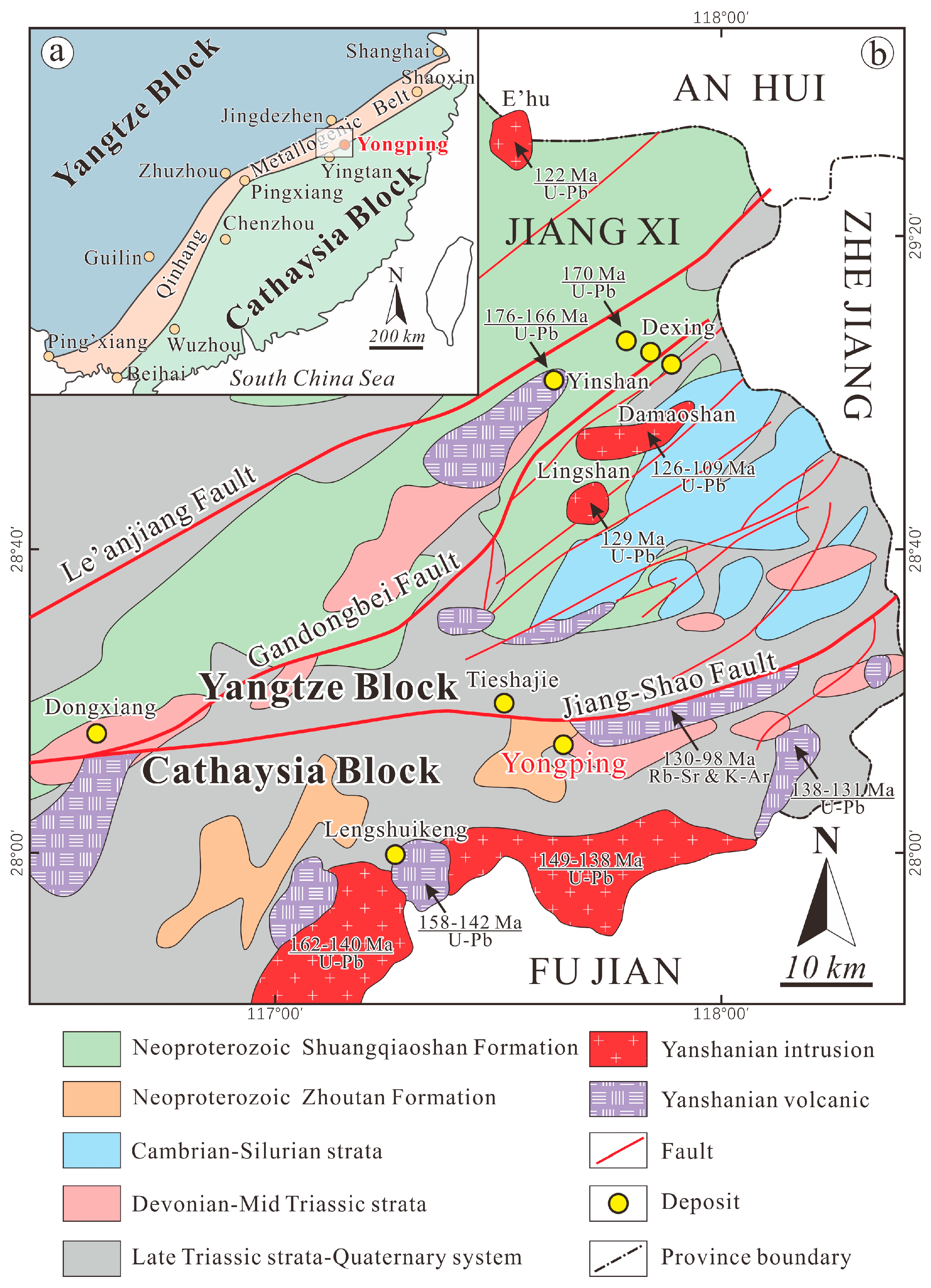
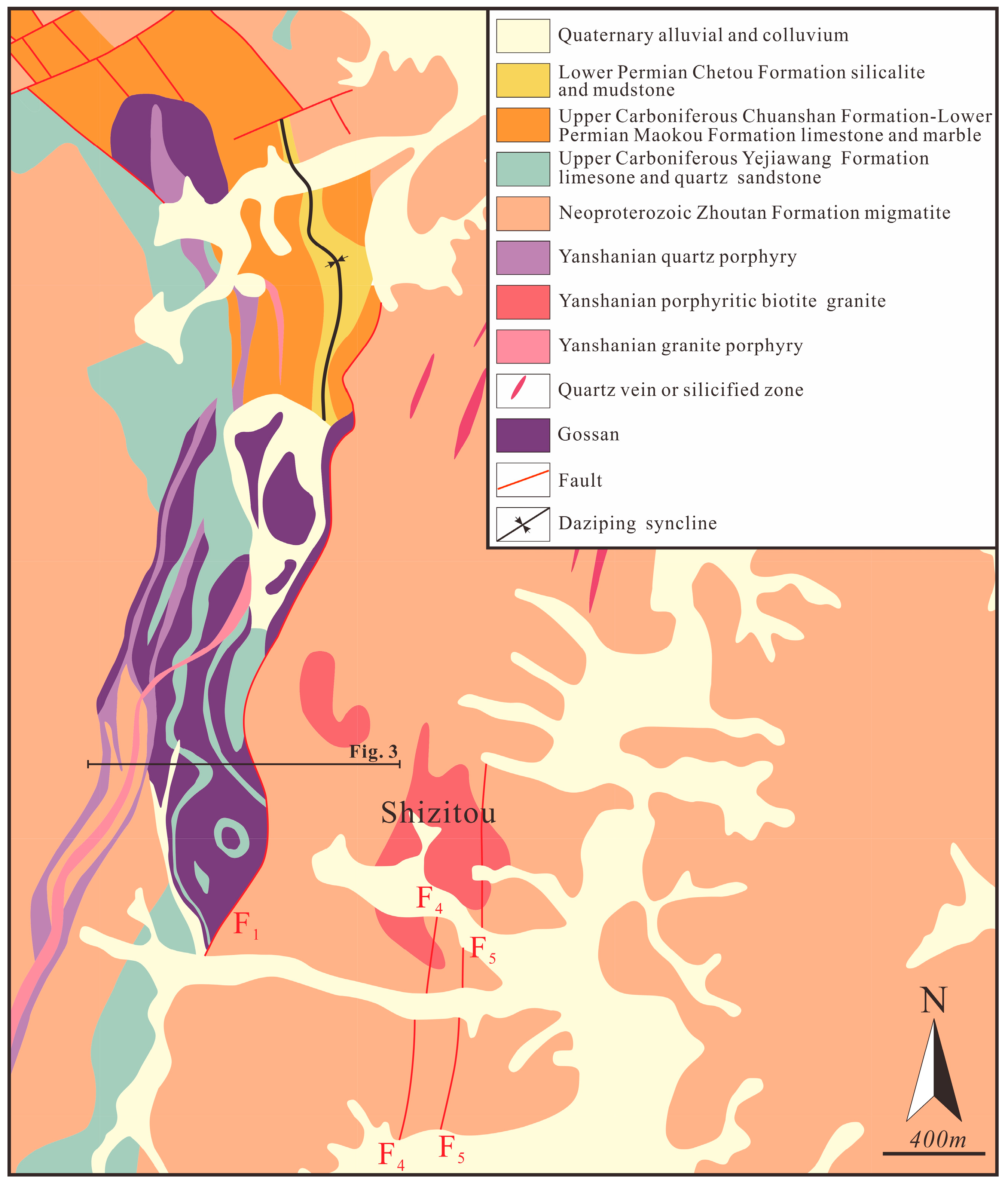
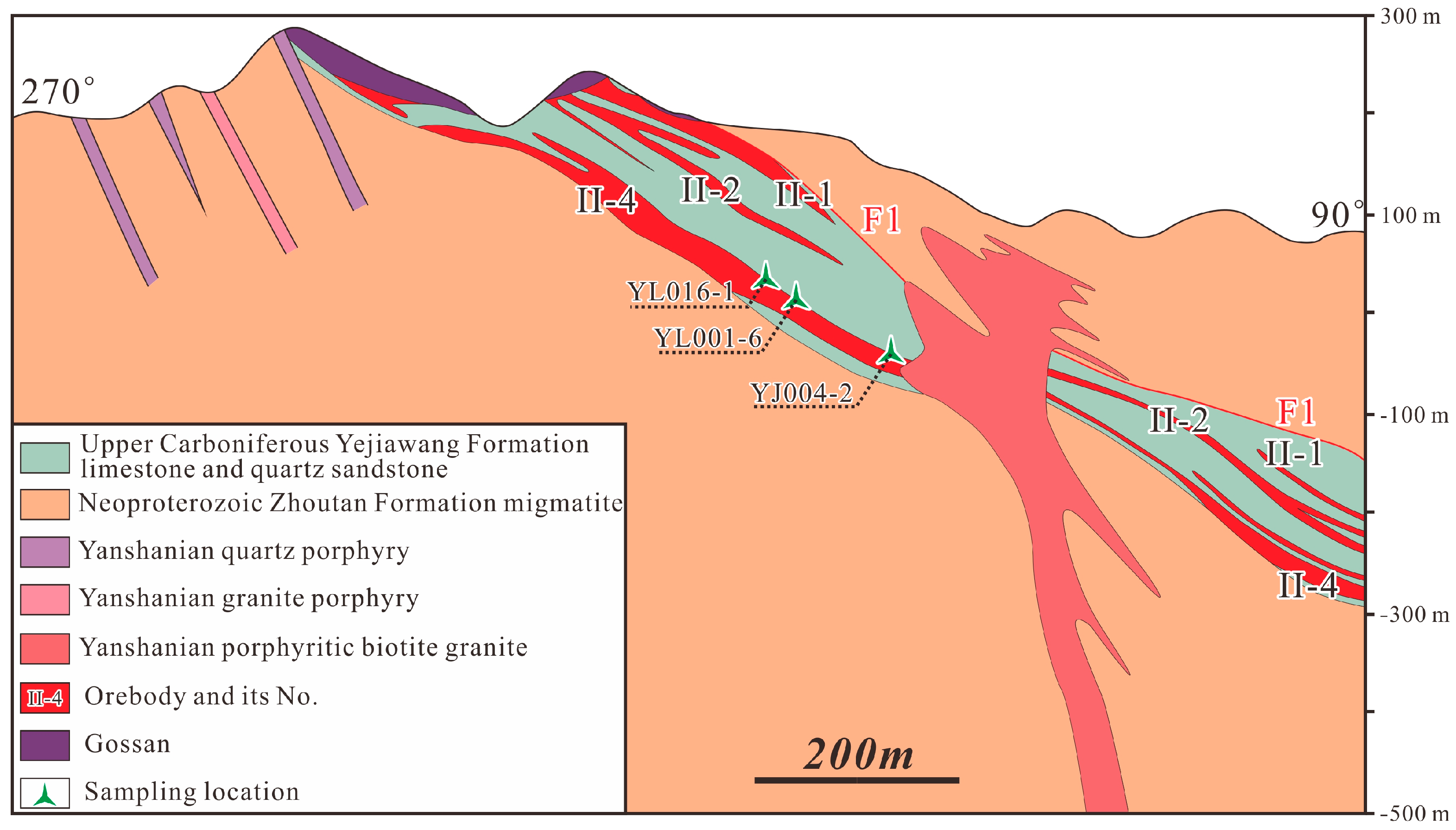

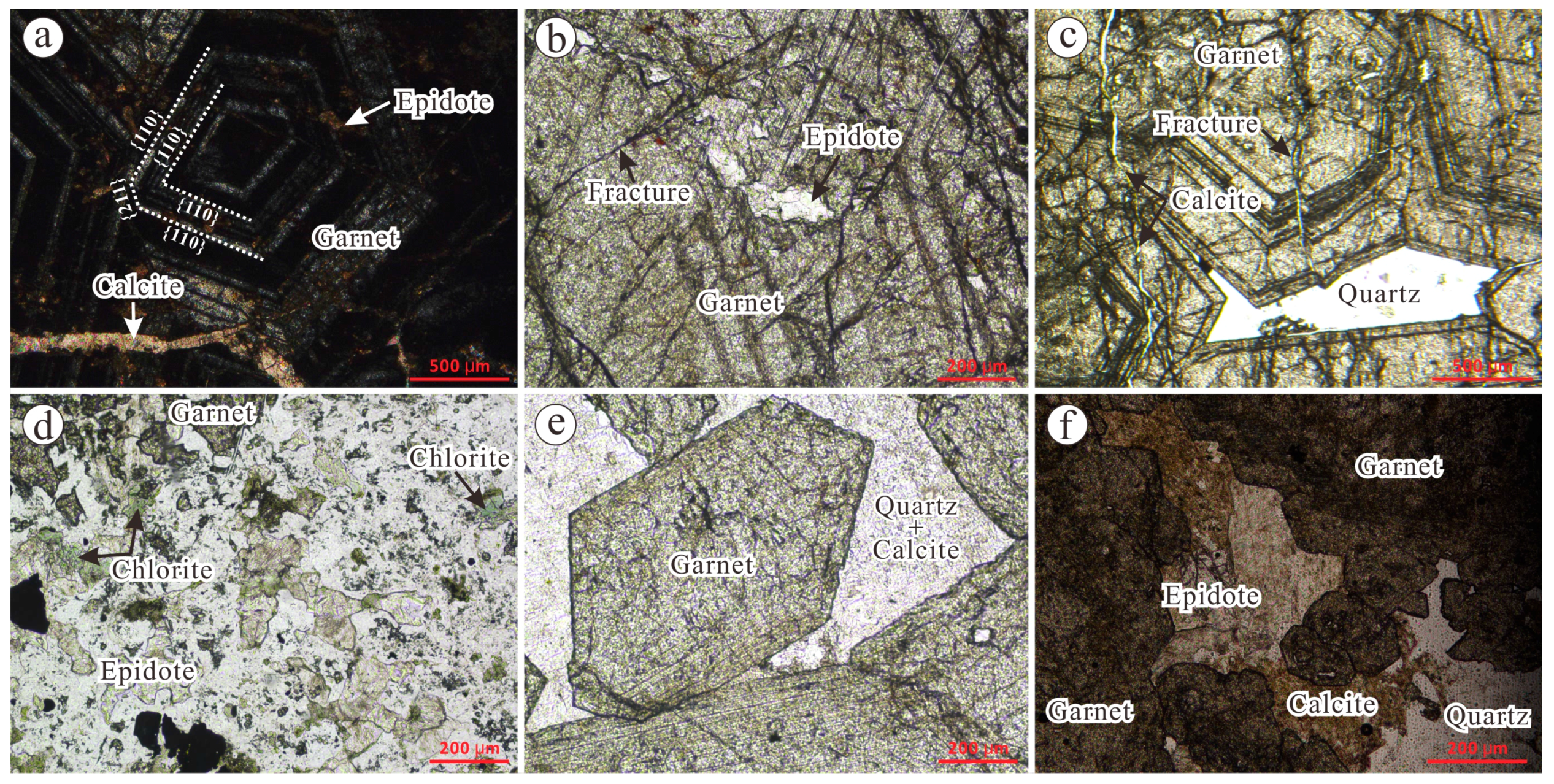
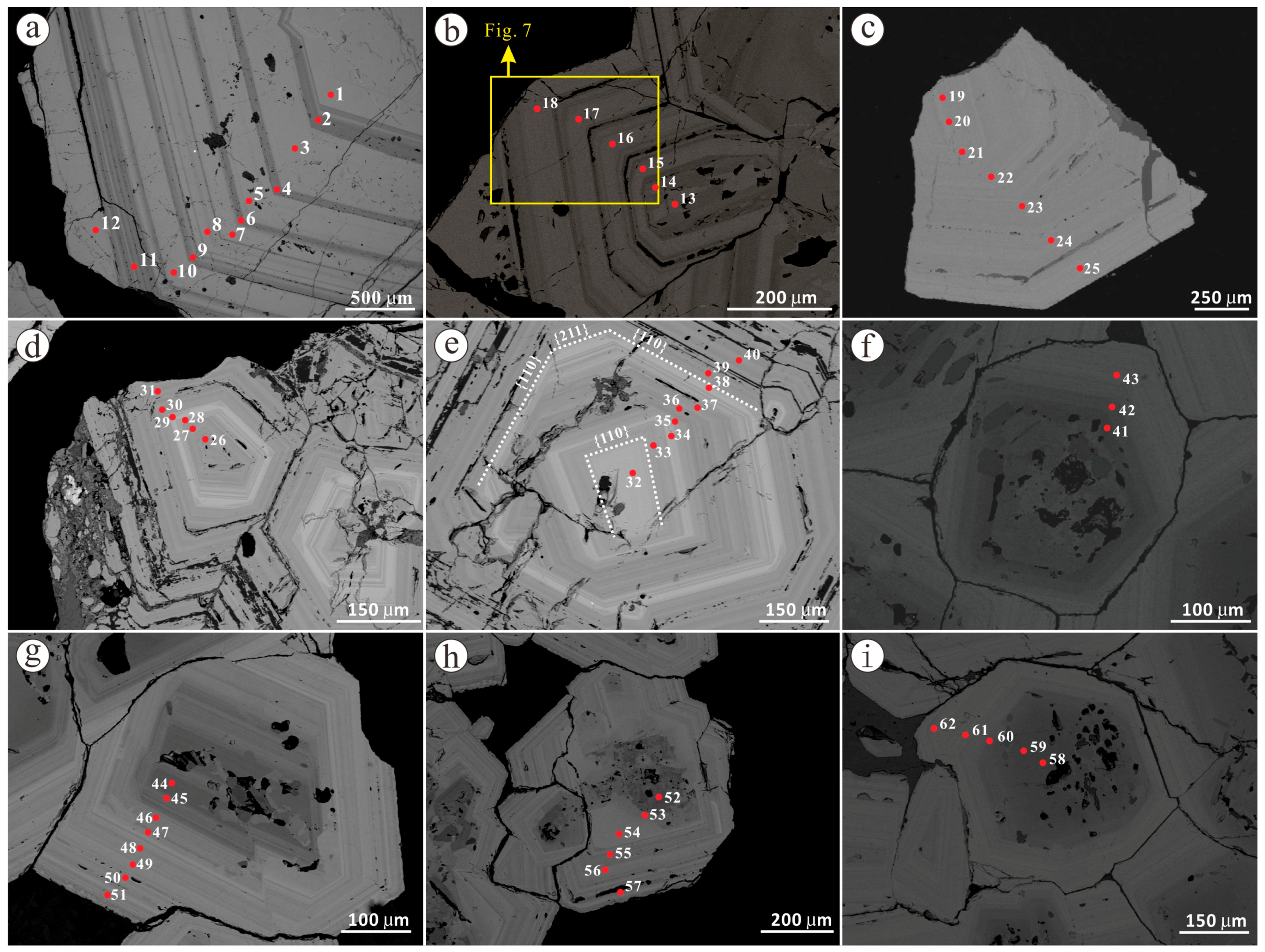
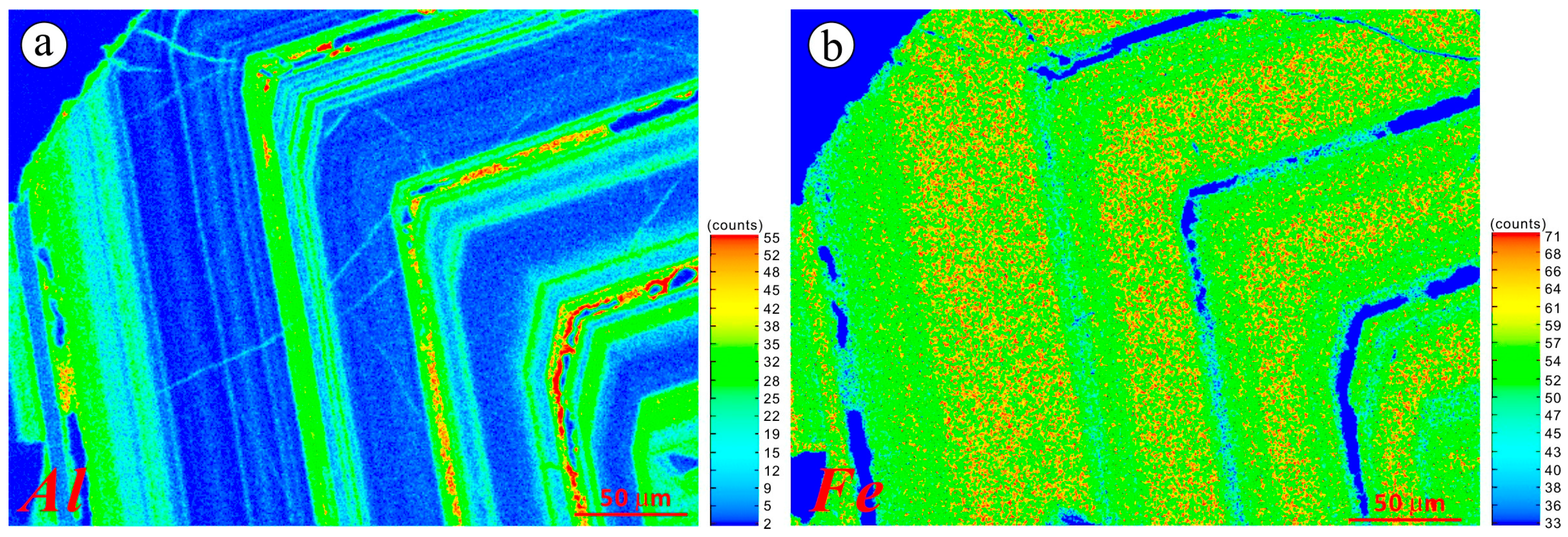


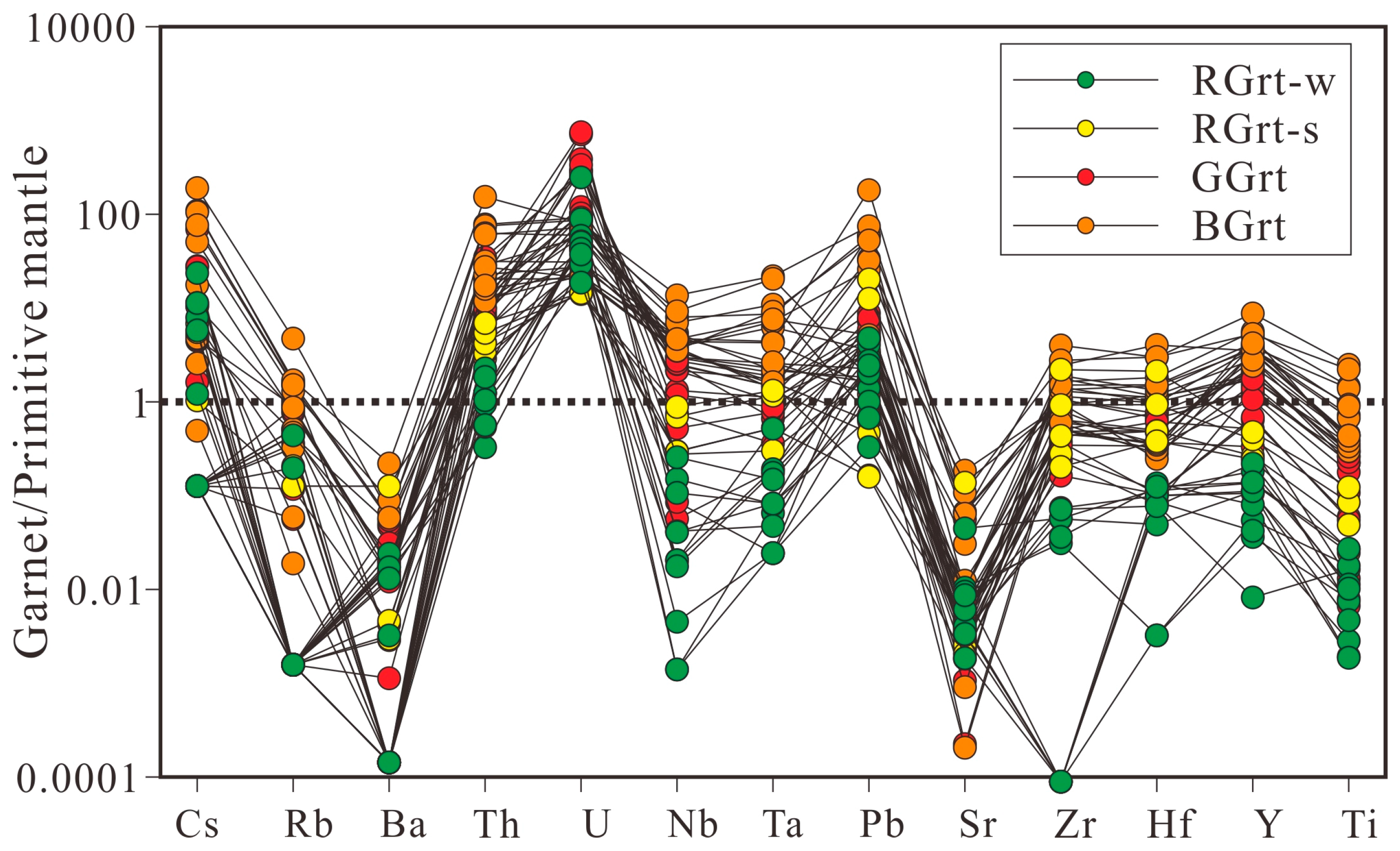

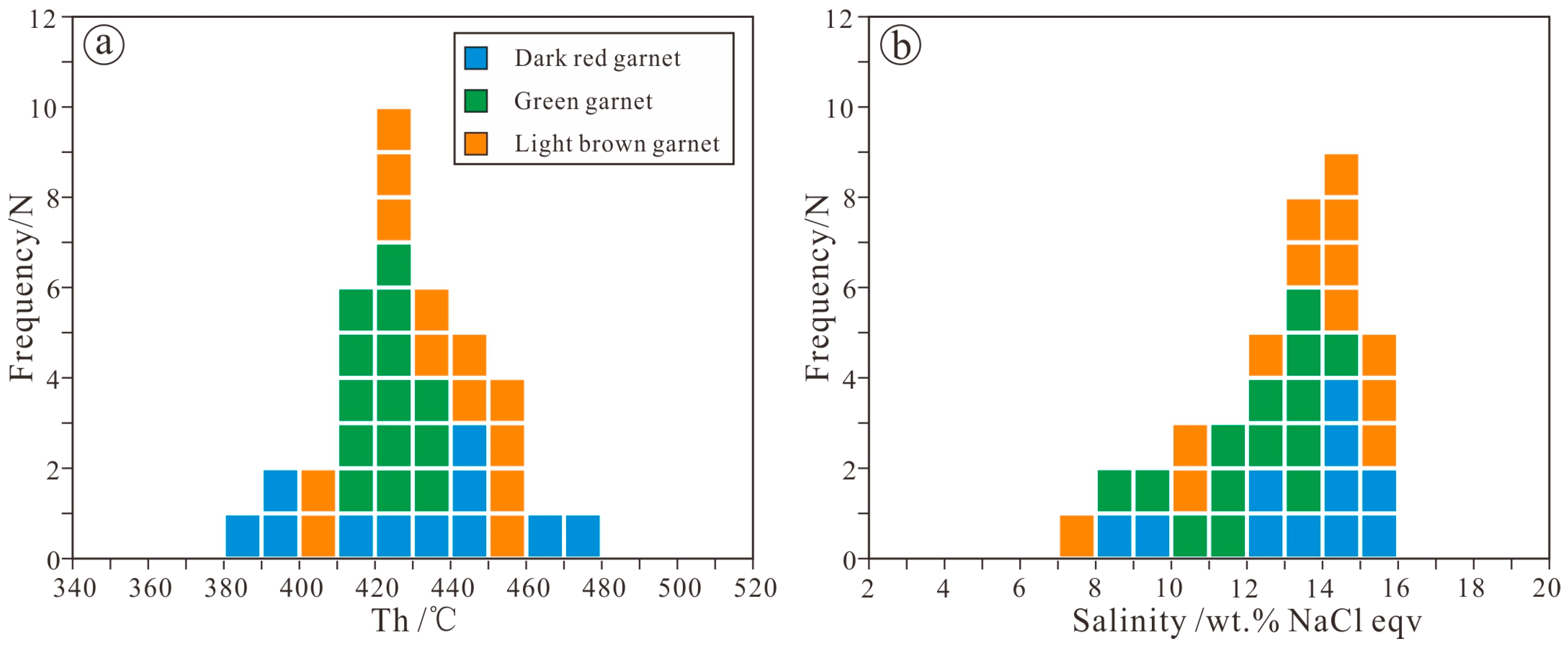

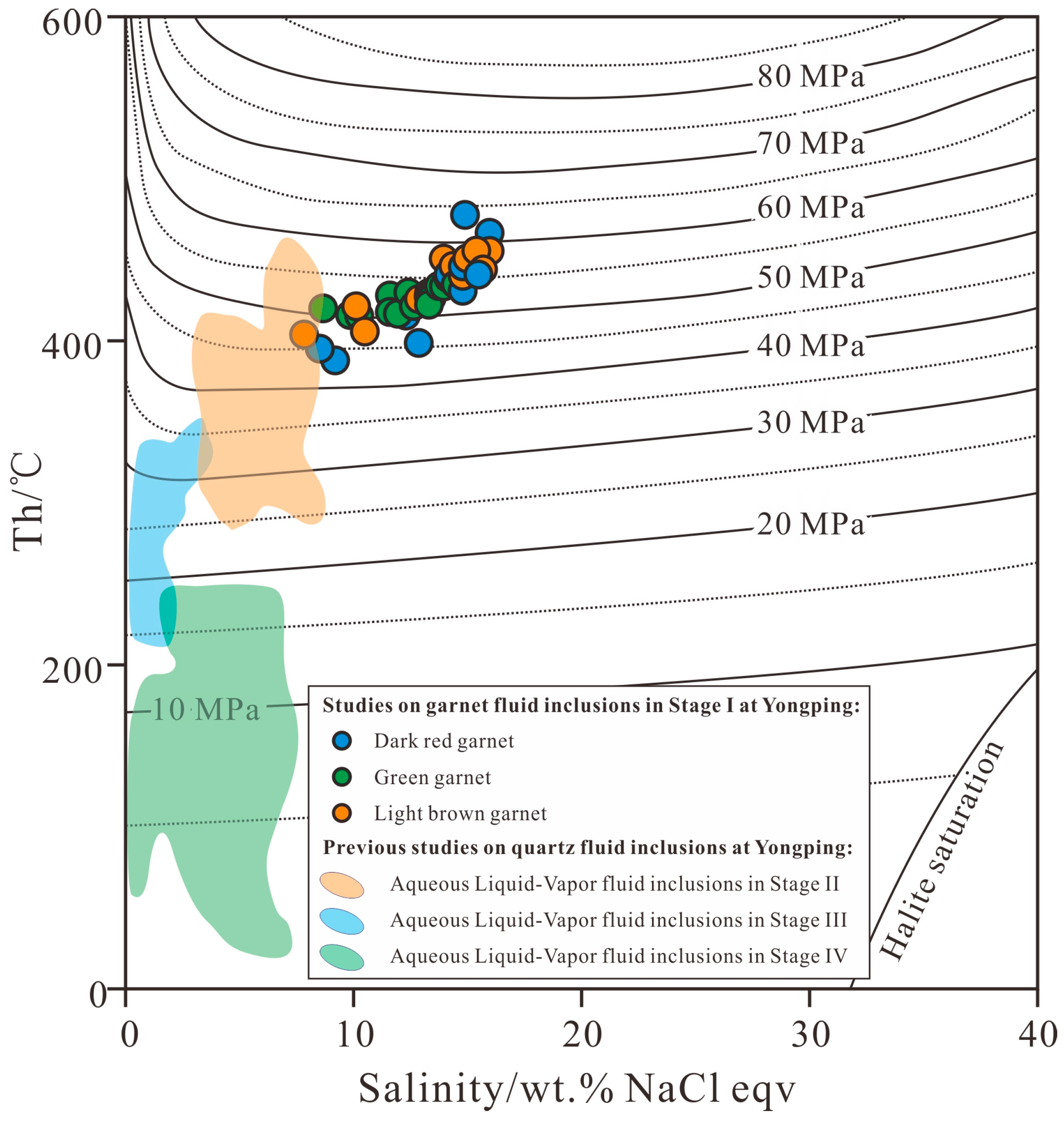
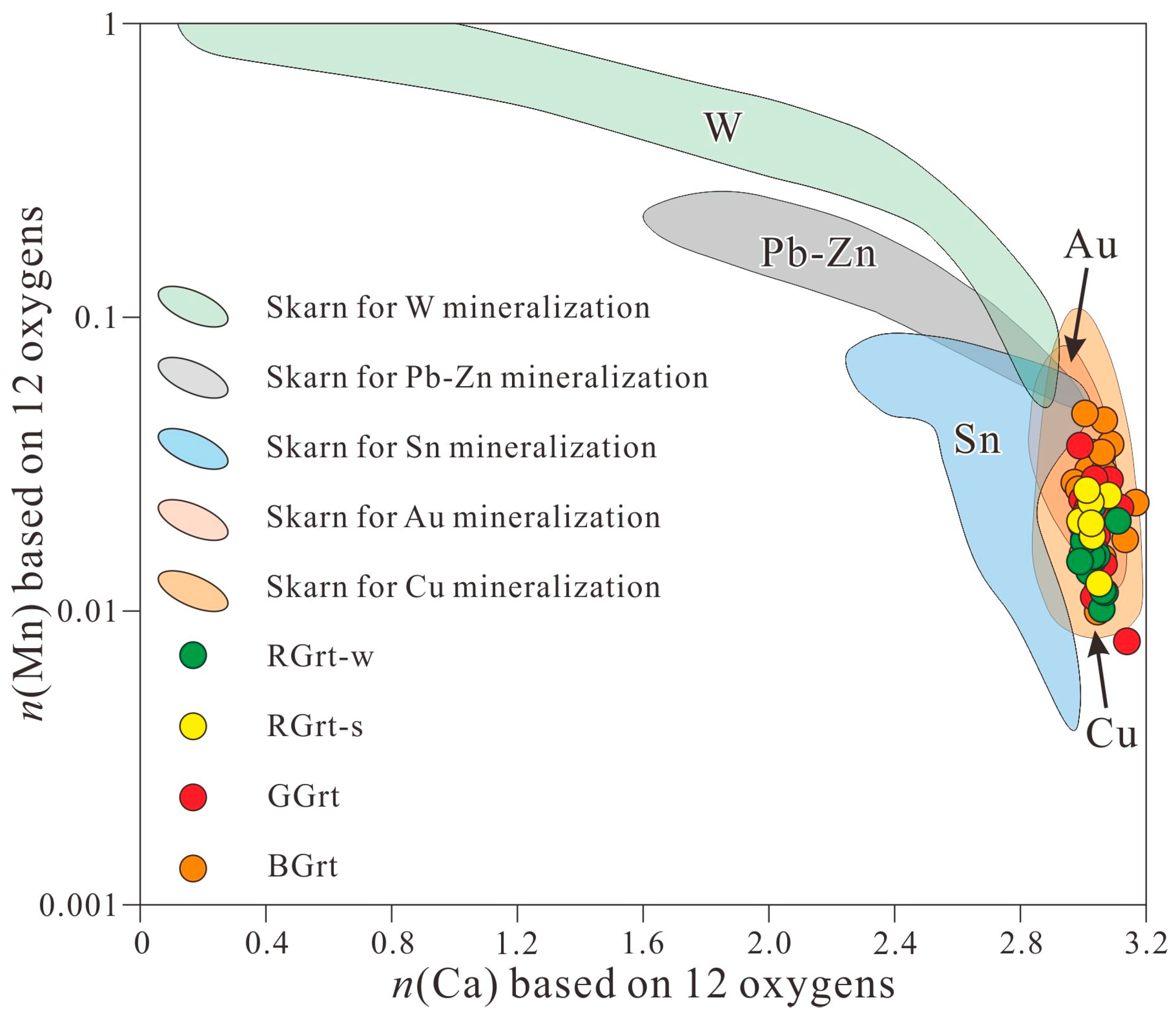
| Type | Spot No. | SiO2 | TiO2 | Al2O3 | Cr2O3 | FeO | MnO | MgO | CaO | Si | Ti | Al | Fe3+ | Fe2+ | Mn | Mg | Ca | Ur | Ad | Py | Sp | Gr | Al |
|---|---|---|---|---|---|---|---|---|---|---|---|---|---|---|---|---|---|---|---|---|---|---|---|
| The dark red garnet sample (YJ004-2) | |||||||||||||||||||||||
| RGrt-w | 1 | 35.18 | 0.08 | 0.02 | bld | 26.99 | 0.32 | 0.18 | 33.09 | 3.01 | 0 | 0 | 1.93 | 0 | 0.02 | 0.02 | 3.03 | 0.01 | 94.11 | 0.73 | 0.74 | 4.41 | 0 |
| RGrt-s | 2 | 36.06 | 0.07 | 6.80 | 0.05 | 19.68 | 0.29 | 0.06 | 34.39 | 2.96 | 0 | 0.66 | 1.35 | 0 | 0.02 | 0.01 | 3.03 | 0.14 | 66.41 | 0.22 | 0.65 | 32.57 | 0 |
| RGrt-w | 3 | 35.11 | bld | 0.19 | 0.02 | 27.92 | 0.25 | 0.16 | 33.02 | 2.98 | 0 | 0.02 | 1.98 | 0 | 0.02 | 0.02 | 3.00 | 0.06 | 97.73 | 0.68 | 0.58 | 0.95 | 0 |
| RGrt-s | 4 | 35.59 | 0.07 | 7.55 | bld | 18.68 | 0.37 | 0.06 | 33.92 | 2.95 | 0 | 0.74 | 1.29 | 0 | 0.03 | 0.01 | 3.01 | 0 | 63.69 | 0.23 | 0.85 | 35.19 | 0.04 |
| RGrt-w | 5 | 34.92 | bld | 0.09 | 0.01 | 27.84 | 0.21 | 0.20 | 33.22 | 2.97 | 0 | 0.01 | 1.98 | 0 | 0.02 | 0.02 | 3.03 | 0.04 | 96.85 | 0.81 | 0.50 | 1.80 | 0 |
| RGrt-s | 6 | 35.63 | 0.01 | 5.96 | 0.05 | 20.55 | 0.33 | 0.05 | 33.96 | 2.96 | 0 | 0.58 | 1.43 | 0 | 0.02 | 0.01 | 3.02 | 0.16 | 70.14 | 0.21 | 0.77 | 28.72 | 0 |
| RGrt-w | 7 | 34.36 | 0.02 | 0.20 | bld | 27.80 | 0.21 | 0.23 | 33.14 | 2.95 | 0 | 0.02 | 1.99 | 0 | 0.02 | 0.03 | 3.04 | 0 | 96.77 | 0.96 | 0.50 | 1.77 | 0 |
| RGrt-w | 8 | 34.76 | 0.05 | 1.44 | 0.04 | 25.47 | 0.14 | 0.10 | 33.33 | 2.98 | 0 | 0.15 | 1.82 | 0 | 0.01 | 0.01 | 3.06 | 0.13 | 88.84 | 0.40 | 0.33 | 10.31 | 0 |
| RGrt-s | 9 | 36.08 | bld | 5.47 | bld | 21.06 | 0.26 | 0.06 | 34.21 | 2.98 | 0 | 0.53 | 1.46 | 0 | 0.02 | 0.01 | 3.03 | 0 | 71.46 | 0.24 | 0.59 | 27.71 | 0 |
| RGrt-w | 10 | 34.38 | 0.05 | 0.15 | bld | 27.81 | 0.19 | 0.19 | 32.76 | 2.96 | 0 | 0.02 | 2.00 | 0 | 0.01 | 0.02 | 3.02 | 0 | 98.16 | 0.81 | 0.45 | 0.59 | 0 |
| RGrt-s | 11 | 35.31 | 0.02 | 7.32 | 0.02 | 18.92 | 0.35 | 0.06 | 34.72 | 2.92 | 0 | 0.71 | 1.31 | 0 | 0.02 | 0.01 | 3.08 | 0.05 | 63.15 | 0.24 | 0.80 | 35.76 | 0 |
| RGrt-w | 12 | 32.82 | bld | 0.05 | 0.05 | 27.98 | 0.27 | 0.18 | 33.10 | 2.88 | 0 | 0.01 | 2.05 | 0 | 0.02 | 0.02 | 3.11 | 0.17 | 97.62 | 0.73 | 0.64 | 0.84 | 0 |
| RGrt-s | 13 | 35.74 | 0.01 | 3.28 | bld | 24.47 | 0.29 | 0.07 | 33.53 | 2.97 | 0 | 0.32 | 1.70 | 0.01 | 0.02 | 0.01 | 2.99 | 0 | 84.04 | 0.27 | 0.67 | 14.77 | 0.26 |
| RGrt-s | 14 | 34.14 | 0.01 | 2.37 | bld | 25.22 | 0.17 | 0.08 | 33.21 | 2.93 | 0 | 0.24 | 1.81 | 0 | 0.01 | 0.01 | 3.05 | 0.01 | 88.27 | 0.31 | 0.40 | 11.00 | 0 |
| RGrt-w | 15 | 33.87 | bld | 0.32 | 0.05 | 27.09 | 0.16 | 0.12 | 32.83 | 2.95 | 0 | 0.03 | 1.97 | 0 | 0.01 | 0.02 | 3.06 | 0.16 | 95.74 | 0.52 | 0.38 | 3.20 | 0 |
| RGrt-w | 16 | 34.64 | bld | 0.47 | 0.05 | 27.04 | 0.16 | 0.13 | 33.49 | 2.96 | 0 | 0.05 | 1.93 | 0 | 0.01 | 0.02 | 3.07 | 0.15 | 93.69 | 0.53 | 0.37 | 5.26 | 0 |
| RGrt-w | 17 | 35.24 | bld | 0.36 | bld | 27.50 | 0.21 | 0.11 | 32.81 | 3.00 | 0 | 0.04 | 1.96 | 0 | 0.01 | 0.01 | 2.99 | 0 | 97.19 | 0.47 | 0.49 | 1.85 | 0 |
| RGrt-w | 18 | 35.44 | bld | 0.09 | 0.01 | 27.87 | 0.24 | 0.09 | 33.11 | 3.00 | 0 | 0.01 | 1.97 | 0 | 0.02 | 0.01 | 3.00 | 0.03 | 97.63 | 0.37 | 0.57 | 1.40 | 0 |
| The green garnet sample (YL001-6) | |||||||||||||||||||||||
| GGrt | 19 | 35.47 | bld | 4.84 | bld | 22.12 | 0.23 | 0.03 | 33.97 | 2.96 | 0 | 0.48 | 1.54 | 0 | 0.02 | 0 | 3.04 | 0 | 75.72 | 0.14 | 0.53 | 23.61 | 0 |
| GGrt | 20 | 33.11 | 0.01 | 0.07 | bld | 27.33 | 0.11 | 0.06 | 33.33 | 2.91 | 0 | 0.01 | 2.01 | 0 | 0.01 | 0.01 | 3.14 | 0 | 95.54 | 0.24 | 0.25 | 3.98 | 0 |
| GGrt | 21 | 36.23 | 0.03 | 7.01 | bld | 19.57 | 0.32 | 0.02 | 34.72 | 2.96 | 0 | 0.68 | 1.34 | 0 | 0.02 | 0 | 3.04 | 0 | 65.45 | 0.08 | 0.72 | 33.75 | 0 |
| GGrt | 22 | 36.55 | 0.01 | 5.99 | bld | 18.94 | 0.32 | 0.02 | 34.37 | 3.03 | 0 | 0.59 | 1.31 | 0 | 0.02 | 0 | 3.06 | 0 | 63.99 | 0.06 | 0.73 | 35.22 | 0 |
| GGrt | 23 | 34.79 | 0.07 | 6.78 | bld | 18.61 | 0.32 | - | 34.50 | 2.93 | 0 | 0.67 | 1.31 | 0 | 0.02 | 0 | 3.12 | 0 | 62.70 | 0.01 | 0.72 | 36.57 | 0 |
| GGrt | 24 | 37.31 | 0.06 | 9.33 | bld | 16.44 | 0.54 | 0.02 | 34.78 | 2.99 | 0 | 0.88 | 1.10 | 0 | 0.04 | 0 | 2.99 | 0 | 54.63 | 0.08 | 1.21 | 44.08 | 0 |
| GGrt | 25 | 35.87 | 0.02 | 3.07 | bld | 23.31 | 0.30 | - | 33.54 | 3.02 | 0 | 0.30 | 1.64 | 0 | 0.02 | 0 | 3.02 | 0 | 80.79 | 0.01 | 0.69 | 18.51 | 0 |
| GGrt | 26 | 36.16 | 0.08 | 8.39 | 0.01 | 17.89 | 0.32 | 0.05 | 34.78 | 2.95 | 0 | 0.81 | 1.22 | 0 | 0.02 | 0.01 | 3.04 | 0.03 | 59.67 | 0.19 | 0.71 | 39.39 | 0 |
| GGrt | 27 | 35.99 | 0.13 | 7.16 | 0.06 | 19.16 | 0.41 | 0.07 | 34.57 | 2.95 | 0.01 | 0.69 | 1.31 | 0 | 0.03 | 0.01 | 3.04 | 0.18 | 64.11 | 0.26 | 0.92 | 34.53 | 0 |
| GGrt | 28 | 35.36 | 0.02 | 3.00 | 0.05 | 24.51 | 0.26 | 0.06 | 33.99 | 2.96 | 0 | 0.30 | 1.71 | 0 | 0.02 | 0.01 | 3.04 | 0.16 | 83.72 | 0.24 | 0.59 | 15.30 | 0 |
| GGrt | 29 | 34.86 | bld | 0.20 | bld | 27.94 | 0.16 | 0.07 | 33.27 | 2.97 | 0 | 0.02 | 1.99 | 0 | 0.01 | 0.01 | 3.03 | 0.01 | 97.68 | 0.28 | 0.37 | 1.66 | 0 |
| GGrt | 30 | 36.96 | 0.01 | 7.68 | bld | 18.60 | 0.31 | 0.02 | 34.61 | 2.99 | 0 | 0.73 | 1.26 | 0 | 0.02 | 0 | 3.00 | 0 | 62.43 | 0.07 | 0.70 | 36.81 | 0 |
| GGrt | 31 | 36.70 | 0.09 | 8.94 | bld | 16.65 | 0.38 | 0.01 | 34.74 | 2.98 | 0.01 | 0.86 | 1.13 | 0 | 0.03 | 0 | 3.02 | 0 | 55.61 | 0.05 | 0.85 | 43.49 | 0 |
| GGrt | 32 | 34.53 | bld | 0.02 | bld | 27.77 | 0.16 | 0.13 | 33.08 | 2.97 | 0 | 0.00 | 1.99 | 0 | 0.01 | 0.02 | 3.04 | 0 | 97.38 | 0.53 | 0.38 | 1.70 | 0 |
| GGrt | 33 | 34.41 | 0.26 | 5.65 | 0.02 | 20.85 | 0.39 | 0.04 | 34.16 | 2.90 | 0.02 | 0.56 | 1.47 | 0 | 0.03 | 0.01 | 3.08 | 0.07 | 70.69 | 0.17 | 0.90 | 28.18 | 0 |
| GGrt | 34 | 35.05 | 0.03 | 1.77 | 0.01 | 26.54 | 0.21 | 0.07 | 33.71 | 2.94 | 0 | 0.18 | 1.86 | 0 | 0.01 | 0.01 | 3.03 | 0.03 | 91.37 | 0.27 | 0.49 | 7.80 | 0.04 |
| GGrt | 35 | 35.81 | 0.14 | 5.20 | 0.00 | 20.48 | 0.34 | 0.04 | 33.91 | 3.00 | 0.01 | 0.51 | 1.43 | 0 | 0.02 | 0 | 3.04 | 0 | 70.04 | 0.15 | 0.77 | 29.04 | 0 |
| GGrt | 36 | 36.51 | bld | 7.03 | 0.04 | 19.61 | 0.33 | 0.05 | 34.57 | 2.97 | 0 | 0.67 | 1.33 | 0 | 0.02 | 0.01 | 3.01 | 0.12 | 65.78 | 0.20 | 0.74 | 33.16 | 0 |
| GGrt | 37 | 36.21 | 0.17 | 7.18 | 0.05 | 18.90 | 0.29 | 0.04 | 34.60 | 2.97 | 0.01 | 0.69 | 1.29 | 0 | 0.02 | 0.01 | 3.04 | 0.15 | 63.42 | 0.16 | 0.65 | 35.61 | 0 |
| GGrt | 38 | 33.61 | bld | 0.31 | 0.04 | 28.20 | 0.20 | 0.09 | 33.13 | 2.90 | 0 | 0.03 | 2.03 | 0.01 | 0.01 | 0.01 | 3.07 | 0.12 | 98.38 | 0.39 | 0.47 | 0.48 | 0.17 |
| GGrt | 39 | 36.78 | 0.02 | 8.42 | bld | 18.20 | 0.35 | 0.01 | 34.66 | 2.97 | 0 | 0.80 | 1.22 | 0.01 | 0.02 | 0 | 3.00 | 0 | 60.35 | 0.05 | 0.79 | 38.51 | 0.29 |
| GGrt | 40 | 35.80 | bld | 6.96 | 0.04 | 19.50 | 0.29 | 0.03 | 34.62 | 2.95 | 0 | 0.68 | 1.34 | 0 | 0.02 | 0 | 3.05 | 0.12 | 65.43 | 0.14 | 0.65 | 33.66 | 0 |
| The light brown garnet sample (YL016-1) | |||||||||||||||||||||||
| BGrt | 41 | 37.59 | 0.20 | 13.94 | bld | 10.74 | 0.71 | 0.06 | 35.64 | 2.96 | 0.01 | 1.29 | 0.71 | 0 | 0.05 | 0.01 | 3.01 | 0 | 34.67 | 0.23 | 1.54 | 63.56 | 0 |
| BGrt | 42 | 36.93 | 0.08 | 6.63 | bld | 20.20 | 0.38 | 0.05 | 34.44 | 2.99 | 0 | 0.63 | 1.37 | 0 | 0.03 | 0.01 | 2.99 | 0 | 67.95 | 0.19 | 0.86 | 30.99 | 0 |
| BGrt | 43 | 36.57 | 0.06 | 5.65 | bld | 20.70 | 0.23 | 0.04 | 34.01 | 3.01 | 0 | 0.55 | 1.42 | 0 | 0.02 | 0.00 | 3.00 | 0 | 70.78 | 0.15 | 0.52 | 28.55 | 0 |
| BGrt | 44 | 37.03 | 0.08 | 14.04 | 0.02 | 10.10 | 0.66 | 0.06 | 36.00 | 2.94 | 0 | 1.32 | 0.67 | 0 | 0.04 | 0.01 | 3.07 | 0.07 | 32.30 | 0.24 | 1.43 | 65.96 | 0 |
| BGrt | 45 | 35.86 | 0.57 | 11.76 | 0.08 | 13.01 | 0.51 | 0.09 | 35.23 | 2.91 | 0.03 | 1.12 | 0.88 | 0 | 0.03 | 0.01 | 3.06 | 0.23 | 42.62 | 0.33 | 1.12 | 55.70 | 0 |
| BGrt | 46 | 37.13 | 0.25 | 7.71 | 0.00 | 18.40 | 0.34 | 0.11 | 34.88 | 2.99 | 0.02 | 0.73 | 1.24 | 0 | 0.02 | 0.01 | 3.01 | 0 | 61.03 | 0.43 | 0.76 | 37.78 | 0 |
| BGrt | 47 | 36.60 | 0.48 | 6.62 | 0.01 | 19.18 | 0.36 | 0.10 | 34.78 | 2.98 | 0.03 | 0.64 | 1.31 | 0 | 0.02 | 0.01 | 3.03 | 0.04 | 63.81 | 0.39 | 0.81 | 34.95 | 0 |
| BGrt | 48 | 36.85 | bld | 5.87 | 0.01 | 21.31 | 0.29 | 0.06 | 34.48 | 2.99 | 0 | 0.56 | 1.44 | 0 | 0.02 | 0.01 | 2.99 | 0.04 | 71.69 | 0.26 | 0.65 | 27.35 | 0 |
| BGrt | 49 | 35.34 | 0.01 | 5.67 | bld | 21.26 | 0.22 | 0.06 | 34.42 | 2.93 | 0 | 0.55 | 1.48 | 0 | 0.02 | 0.01 | 3.06 | 0 | 71.80 | 0.22 | 0.49 | 27.49 | 0 |
| BGrt | 50 | 36.94 | 0.01 | 5.85 | bld | 20.80 | 0.20 | 0.02 | 34.64 | 3.00 | 0 | 0.56 | 1.41 | 0 | 0.01 | 0 | 3.02 | 0 | 69.93 | 0.09 | 0.46 | 29.52 | 0 |
| BGrt | 51 | 36.23 | 0.06 | 6.81 | 0.03 | 17.00 | 0.52 | 0.01 | 34.39 | 3.03 | 0 | 0.67 | 1.19 | 0 | 0.04 | 0 | 3.09 | 0.09 | 57.18 | 0.02 | 1.18 | 41.52 | 0 |
| BGrt | 52 | 35.43 | 0.30 | 11.84 | 0.03 | 12.85 | 0.43 | 0.09 | 34.87 | 2.91 | 0.02 | 1.14 | 0.88 | 0 | 0.03 | 0.01 | 3.07 | 0.10 | 42.59 | 0.36 | 0.96 | 55.99 | 0 |
| BGrt | 53 | 35.66 | 0.11 | 7.29 | bld | 18.87 | 0.39 | 0.09 | 33.31 | 2.97 | 0.01 | 0.72 | 1.30 | 0.01 | 0.03 | 0.01 | 2.97 | 0 | 64.51 | 0.37 | 0.91 | 33.76 | 0.46 |
| BGrt | 54 | 35.62 | 0.00 | 5.26 | bld | 22.14 | 0.29 | 0.05 | 33.73 | 2.96 | 0 | 0.51 | 1.52 | 0.02 | 0.02 | 0.01 | 3.00 | 0 | 74.66 | 0.19 | 0.67 | 23.80 | 0.68 |
| BGrt | 55 | 34.08 | 0.00 | 6.38 | bld | 20.74 | 0.31 | 0.05 | 34.41 | 2.87 | 0 | 0.63 | 1.46 | 0 | 0.02 | 0.01 | 3.10 | 0 | 69.70 | 0.18 | 0.71 | 29.31 | 0.10 |
| BGrt | 56 | 36.37 | 0.14 | 6.56 | 0.03 | 19.84 | 0.14 | 0.05 | 34.82 | 2.97 | 0.01 | 0.63 | 1.36 | 0 | 0.01 | 0.01 | 3.05 | 0.08 | 66.37 | 0.21 | 0.33 | 33.01 | 0 |
| BGrt | 57 | 34.20 | 0.08 | 4.74 | bld | 21.72 | 0.24 | 0.05 | 34.45 | 2.90 | 0.01 | 0.47 | 1.54 | 0 | 0.02 | 0.01 | 3.13 | 0 | 73.24 | 0.22 | 0.56 | 25.98 | 0 |
| BGrt | 58 | 38.15 | 0.34 | 11.85 | 0.04 | 12.47 | 0.45 | 0.10 | 35.70 | 3.01 | 0.02 | 1.10 | 0.82 | 0 | 0.03 | 0.01 | 3.02 | 0.12 | 40.35 | 0.37 | 0.99 | 58.18 | 0 |
| BGrt | 59 | 37.51 | 0.13 | 11.84 | 0.07 | 12.46 | 0.51 | 0.13 | 35.49 | 2.99 | 0.01 | 1.11 | 0.83 | 0 | 0.03 | 0.02 | 3.03 | 0.22 | 40.43 | 0.51 | 1.12 | 57.73 | 0 |
| BGrt | 60 | 37.52 | 0.10 | 7.99 | 0.02 | 16.96 | 0.34 | 0.08 | 34.84 | 3.04 | 0.01 | 0.76 | 1.15 | 0 | 0.02 | 0.01 | 3.02 | 0.06 | 56.39 | 0.30 | 0.76 | 42.49 | 0 |
| BGrt | 61 | 36.44 | 0.48 | 11.98 | bld | 12.55 | 0.50 | 0.08 | 35.51 | 2.93 | 0.03 | 1.14 | 0.84 | 0 | 0.03 | 0.01 | 3.06 | 0 | 40.81 | 0.31 | 1.11 | 57.78 | 0 |
| BGrt | 62 | 36.59 | 0.15 | 7.34 | bld | 18.54 | 0.41 | 0.04 | 34.62 | 2.98 | 0.01 | 0.71 | 1.26 | 0 | 0.03 | 0 | 3.02 | 0 | 62.05 | 0.15 | 0.92 | 36.89 | 0 |
| Type | Spot No. | La | Ce | Pr | Nd | Sm | Eu | Gd | Tb | Dy | Ho | Er | Tm | Yb | Lu | ΣREE | ΣLREE | ΣHREE | ΣLREE/ΣHREE | LaN/YbN | δEu | δCe |
|---|---|---|---|---|---|---|---|---|---|---|---|---|---|---|---|---|---|---|---|---|---|---|
| The dark red garnet sample (YJ004-2) | ||||||||||||||||||||||
| RGrt-w | 1 | 11.930 | 26.495 | 2.271 | 5.173 | 0.302 | 0.585 | 0.173 | 0.017 | 0.044 | 0.029 | 0.035 | 0.010 | 0.028 | 0.005 | 47.097 | 46.756 | 0.341 | 137.08 | 304.40 | 7.17 | 1.17 |
| RGrt-s | 2 | 0.343 | 1.199 | 0.249 | 1.612 | 0.336 | 0.258 | 0.204 | 0.020 | 0.216 | 0.055 | 0.209 | 0.029 | 0.144 | 0.021 | 4.895 | 3.996 | 0.899 | 4.44 | 1.70 | 2.79 | 0.96 |
| RGrt-w | 3 | 2.122 | 1.731 | 0.105 | 0.364 | 0.023 | 0.117 | 0.009 | 0.021 | 0.097 | 0.014 | 0.070 | 0.015 | 0.065 | 0.011 | 4.766 | 4.463 | 0.303 | 14.73 | 23.47 | 20.54 | 0.56 |
| RGrt-s | 4 | 0.336 | 0.955 | 0.161 | 1.103 | 0.388 | 0.222 | 0.221 | 0.024 | 0.214 | 0.045 | 0.156 | 0.005 | 0.184 | 0.019 | 4.033 | 3.165 | 0.868 | 3.65 | 1.31 | 2.12 | 1.00 |
| RGrt-w | 5 | 3.196 | 3.764 | 0.211 | 0.618 | 0.109 | 0.145 | 0.092 | 0.004 | 0.032 | 0.005 | 0.030 | 0.008 | 0.052 | 0.001 | 8.267 | 8.043 | 0.223 | 36.02 | 44.36 | 4.31 | 0.78 |
| RGrt-s | 6 | 0.990 | 2.349 | 0.263 | 1.005 | 0.148 | 0.364 | 0.067 | 0.027 | 0.094 | 0.024 | 0.046 | 0.013 | 0.060 | 0.013 | 5.462 | 5.119 | 0.343 | 14.93 | 11.91 | 9.73 | 1.11 |
| RGrt-w | 7 | 3.670 | 3.936 | 0.203 | 0.373 | 0.036 | 0.086 | 0.053 | 0.013 | 0.037 | 0.012 | 0.019 | 0.002 | 0.057 | 0.001 | 8.496 | 8.303 | 0.193 | 42.97 | 46.33 | 6.00 | 0.73 |
| RGrt-w | 8 | 1.937 | 3.146 | 0.290 | 0.643 | 0.030 | 0.079 | 0.013 | 0.005 | 0.055 | 0.007 | 0.059 | 0.008 | 0.019 | 0.005 | 6.299 | 6.126 | 0.172 | 35.54 | 71.47 | 10.46 | 0.92 |
| RGrt-s | 9 | 0.211 | 1.071 | 0.159 | 1.149 | 0.226 | 0.135 | 0.075 | 0.023 | 0.108 | 0.025 | 0.068 | 0.013 | 0.017 | 0.005 | 3.286 | 2.950 | 0.336 | 8.79 | 8.94 | 2.52 | 1.36 |
| RGrt-w | 10 | 2.717 | 2.879 | 0.183 | 0.451 | 0.030 | 0.125 | 0.043 | 0.009 | 0.025 | 0.005 | 0.023 | 0.005 | 0.024 | 0.001 | 6.520 | 6.385 | 0.135 | 47.39 | 81.99 | 10.64 | 0.70 |
| RGrt-s | 11 | 0.277 | 0.835 | 0.144 | 0.523 | 0.118 | 0.079 | 0.061 | 0.023 | 0.114 | 0.017 | 0.032 | 0.005 | 0.108 | 0.019 | 2.355 | 1.974 | 0.380 | 5.19 | 1.85 | 2.54 | 1.02 |
| RGrt-w | 12 | 3.389 | 2.616 | 0.159 | 0.457 | 0.088 | 0.066 | 0.019 | 0.001 | 0.031 | 0.004 | 0.034 | 0.001 | 0.031 | 0.001 | 6.898 | 6.776 | 0.122 | 55.48 | 78.42 | 3.42 | 0.54 |
| RGrt-w | 15 | 0.539 | 1.113 | 0.150 | 0.294 | 0.051 | 0.095 | 0.026 | 0.019 | 0.010 | 0.020 | 0.076 | 0.001 | 0.063 | 0.003 | 2.460 | 2.242 | 0.218 | 10.30 | 6.13 | 7.14 | 0.94 |
| RGrt-w | 16 | 0.849 | 1.682 | 0.121 | 0.344 | 0.082 | 0.082 | 0.021 | 0.013 | 0.013 | 0.013 | 0.053 | 0.001 | 0.048 | 0.001 | 3.324 | 3.160 | 0.163 | 19.35 | 12.60 | 4.46 | 1.13 |
| RGrt-w | 17 | 1.301 | 2.133 | 0.210 | 0.686 | 0.148 | 0.108 | 0.056 | 0.014 | 0.049 | 0.007 | 0.061 | 0.001 | 0.039 | 0.010 | 4.823 | 4.587 | 0.237 | 19.39 | 23.92 | 3.00 | 0.91 |
| RGrt-w | 18 | 3.417 | 9.750 | 0.743 | 1.042 | 0.093 | 0.188 | 0.023 | 0.012 | 0.044 | 0.003 | 0.053 | 0.001 | 0.033 | 0.003 | 15.405 | 15.234 | 0.172 | 88.70 | 74.05 | 9.04 | 1.43 |
| The green garnet sample (YL001-6) | ||||||||||||||||||||||
| GGrt | 26 | 0.376 | 3.438 | 1.094 | 9.455 | 2.762 | 0.792 | 1.900 | 0.237 | 1.361 | 0.243 | 0.580 | 0.099 | 0.430 | 0.090 | 22.854 | 17.916 | 4.938 | 3.63 | 0.63 | 1.00 | 0.86 |
| GGrt | 27 | 0.448 | 3.531 | 1.200 | 9.310 | 2.599 | 0.640 | 2.233 | 0.264 | 1.522 | 0.247 | 0.790 | 0.110 | 0.611 | 0.126 | 23.631 | 17.729 | 5.903 | 3.00 | 0.53 | 0.79 | 0.79 |
| GGrt | 28 | 3.164 | 14.569 | 2.259 | 11.564 | 2.146 | 0.789 | 1.393 | 0.199 | 0.877 | 0.161 | 0.365 | 0.060 | 0.380 | 0.039 | 37.964 | 34.491 | 3.473 | 9.93 | 5.97 | 1.31 | 1.28 |
| GGrt | 29 | 2.258 | 12.058 | 2.196 | 11.114 | 2.548 | 0.639 | 1.269 | 0.127 | 0.478 | 0.101 | 0.116 | 0.038 | 0.170 | 0.022 | 33.135 | 30.813 | 2.322 | 13.27 | 9.53 | 0.96 | 1.21 |
| GGrt | 30 | 0.478 | 4.041 | 1.395 | 12.382 | 4.221 | 1.212 | 3.025 | 0.379 | 1.831 | 0.315 | 0.853 | 0.103 | 0.656 | 0.068 | 30.960 | 23.729 | 7.231 | 3.28 | 0.52 | 0.99 | 0.79 |
| GGrt | 31 | 0.148 | 1.811 | 0.663 | 7.047 | 2.926 | 0.630 | 2.079 | 0.234 | 1.441 | 0.254 | 0.463 | 0.077 | 0.487 | 0.091 | 18.352 | 13.226 | 5.126 | 2.58 | 0.22 | 0.74 | 0.78 |
| GGrt | 32 | 5.478 | 40.976 | 6.742 | 20.236 | 1.716 | 0.697 | 0.603 | 0.056 | 0.340 | 0.060 | 0.196 | 0.018 | 0.138 | 0.022 | 77.277 | 75.845 | 1.432 | 52.95 | 28.47 | 1.70 | 1.42 |
| GGrt | 33 | 6.078 | 38.542 | 5.285 | 13.844 | 1.176 | 0.479 | 0.603 | 0.030 | 0.274 | 0.019 | 0.143 | 0.018 | 0.087 | 0.025 | 66.602 | 65.404 | 1.198 | 54.60 | 49.95 | 1.56 | 1.55 |
| GGrt | 34 | 1.773 | 15.345 | 3.728 | 18.950 | 2.522 | 0.944 | 1.153 | 0.137 | 0.648 | 0.167 | 0.463 | 0.032 | 0.233 | 0.047 | 46.142 | 43.261 | 2.881 | 15.02 | 5.46 | 1.47 | 1.07 |
| GGrt | 35 | 1.930 | 17.598 | 3.764 | 16.851 | 1.875 | 0.682 | 0.970 | 0.154 | 0.693 | 0.153 | 0.351 | 0.045 | 0.341 | 0.059 | 45.465 | 42.700 | 2.765 | 15.44 | 4.06 | 1.39 | 1.20 |
| GGrt | 36 | 0.145 | 2.800 | 0.969 | 8.156 | 2.831 | 0.777 | 2.234 | 0.208 | 1.755 | 0.297 | 0.651 | 0.078 | 0.484 | 0.096 | 21.482 | 15.678 | 5.803 | 2.70 | 0.21 | 0.91 | 0.85 |
| GGrt | 37 | 0.300 | 3.526 | 1.193 | 9.761 | 2.897 | 0.740 | 1.465 | 0.251 | 1.454 | 0.267 | 0.690 | 0.085 | 0.645 | 0.102 | 23.376 | 18.416 | 4.960 | 3.71 | 0.33 | 0.98 | 0.83 |
| GGrt | 38 | 3.555 | 16.112 | 2.264 | 9.435 | 1.434 | 0.540 | 0.739 | 0.121 | 0.467 | 0.103 | 0.199 | 0.029 | 0.193 | 0.025 | 35.215 | 33.339 | 1.875 | 17.78 | 13.24 | 1.44 | 1.36 |
| GGrt | 39 | 0.490 | 4.576 | 1.569 | 13.767 | 4.020 | 1.193 | 2.771 | 0.426 | 1.664 | 0.287 | 0.840 | 0.161 | 0.588 | 0.078 | 32.431 | 25.616 | 6.815 | 3.76 | 0.60 | 1.03 | 0.80 |
| GGrt | 40 | 0.227 | 2.542 | 1.101 | 8.592 | 2.899 | 0.826 | 2.432 | 0.323 | 1.299 | 0.260 | 0.566 | 0.081 | 0.391 | 0.111 | 21.649 | 16.187 | 5.462 | 2.96 | 0.42 | 0.93 | 0.66 |
| The light brown garnet sample (YL016-1) | ||||||||||||||||||||||
| BGrt | 41 | 1.375 | 11.714 | 1.733 | 8.311 | 2.527 | 0.567 | 3.087 | 0.388 | 2.546 | 0.509 | 1.329 | 0.202 | 1.101 | 0.192 | 35.582 | 26.226 | 9.355 | 2.80 | 0.90 | 0.62 | 1.59 |
| BGrt | 43 | 0.393 | 4.213 | 1.473 | 11.370 | 3.639 | 0.955 | 3.245 | 0.396 | 2.313 | 0.412 | 0.855 | 0.132 | 0.520 | 0.060 | 29.977 | 22.043 | 7.934 | 2.78 | 0.54 | 0.83 | 0.80 |
| BGrt | 45 | 1.401 | 3.977 | 0.506 | 2.720 | 1.523 | 0.430 | 2.424 | 0.400 | 2.086 | 0.370 | 1.138 | 0.148 | 1.101 | 0.167 | 18.390 | 10.556 | 7.834 | 1.35 | 0.91 | 0.68 | 1.16 |
| BGrt | 47 | 0.676 | 8.591 | 2.544 | 17.429 | 5.227 | 1.144 | 5.595 | 0.707 | 3.775 | 0.731 | 1.873 | 0.170 | 1.112 | 0.196 | 49.769 | 35.611 | 14.159 | 2.52 | 0.44 | 0.64 | 0.95 |
| BGrt | 48 | 0.656 | 7.863 | 2.486 | 17.677 | 4.527 | 1.178 | 4.516 | 0.506 | 2.871 | 0.520 | 1.291 | 0.180 | 1.005 | 0.118 | 45.394 | 34.387 | 11.006 | 3.12 | 0.47 | 0.79 | 0.89 |
| BGrt | 49 | 0.496 | 5.399 | 1.682 | 12.416 | 3.853 | 0.845 | 3.268 | 0.439 | 2.479 | 0.454 | 1.118 | 0.097 | 0.793 | 0.100 | 33.437 | 24.690 | 8.747 | 2.82 | 0.45 | 0.71 | 0.89 |
| BGrt | 50 | 0.427 | 5.240 | 1.494 | 10.737 | 3.613 | 0.875 | 3.704 | 0.488 | 2.820 | 0.571 | 1.268 | 0.128 | 1.224 | 0.109 | 32.698 | 22.386 | 10.312 | 2.17 | 0.25 | 0.72 | 0.98 |
| BGrt | 53 | 0.833 | 6.812 | 1.993 | 15.766 | 4.508 | 1.199 | 6.244 | 0.965 | 5.724 | 1.071 | 3.254 | 0.421 | 2.688 | 0.370 | 51.847 | 31.111 | 20.736 | 1.50 | 0.22 | 0.69 | 0.91 |
| BGrt | 55 | 0.329 | 3.656 | 1.276 | 10.253 | 2.899 | 0.824 | 2.991 | 0.338 | 1.781 | 0.300 | 0.763 | 0.091 | 0.701 | 0.073 | 26.276 | 19.237 | 7.039 | 2.73 | 0.34 | 0.85 | 0.81 |
| BGrt | 56 | 0.579 | 7.747 | 2.002 | 12.473 | 3.846 | 0.746 | 5.033 | 0.673 | 3.853 | 0.649 | 1.509 | 0.167 | 1.003 | 0.123 | 40.404 | 27.393 | 13.011 | 2.11 | 0.41 | 0.52 | 1.08 |
| BGrt | 58 | 1.014 | 9.286 | 2.584 | 18.298 | 5.323 | 0.971 | 3.802 | 0.407 | 2.083 | 0.451 | 1.063 | 0.174 | 0.940 | 0.153 | 46.550 | 37.476 | 9.074 | 4.13 | 0.77 | 0.63 | 0.96 |
| BGrt | 59 | 1.091 | 9.901 | 2.902 | 18.971 | 4.960 | 0.878 | 3.629 | 0.374 | 1.915 | 0.356 | 0.848 | 0.134 | 0.625 | 0.113 | 46.698 | 38.703 | 7.995 | 4.84 | 1.25 | 0.60 | 0.92 |
| BGrt | 60 | 0.759 | 8.559 | 2.599 | 14.961 | 4.031 | 0.752 | 3.656 | 0.467 | 2.264 | 0.424 | 1.024 | 0.125 | 1.166 | 0.194 | 40.979 | 31.661 | 9.319 | 3.40 | 0.47 | 0.59 | 0.92 |
| BGrt | 61 | 0.288 | 4.093 | 1.315 | 12.493 | 5.379 | 1.011 | 5.649 | 0.723 | 4.188 | 0.776 | 1.695 | 0.264 | 1.155 | 0.183 | 39.213 | 24.579 | 14.634 | 1.68 | 0.18 | 0.56 | 0.89 |
| BGrt | 62 | 0.390 | 4.366 | 1.268 | 9.755 | 3.459 | 0.877 | 3.193 | 0.475 | 2.409 | 0.470 | 0.920 | 0.128 | 0.943 | 0.114 | 28.767 | 20.116 | 8.651 | 2.33 | 0.30 | 0.79 | 0.95 |
| Type | Spot No. | Cs | Rb | Ba | Th | U | Nb | Ta | Pb | Sr | Zr | Hf | Y | Ti |
|---|---|---|---|---|---|---|---|---|---|---|---|---|---|---|
| The dark red garnet sample (YJ004-2) | ||||||||||||||
| RGrt-w | 1 | bld | bld | bld | 0.157 | 5.196 | 0.183 | 0.006 | 0.174 | 0.183 | 0.407 | 0.039 | 0.633 | 35.355 |
| RGrt-s | 2 | bld | bld | 0.021 | 0.589 | 0.305 | 0.630 | 0.054 | 0.033 | 0.202 | 24.723 | 0.655 | 2.171 | 159.850 |
| RGrt-w | 3 | bld | bld | bld | 0.193 | 0.785 | 0.076 | 0.003 | 0.048 | 0.071 | 0.800 | 0.024 | 0.999 | 13.264 |
| RGrt-s | 4 | 0.008 | 0.080 | 0.881 | 0.462 | 0.297 | 0.495 | 0.048 | 0.893 | 2.902 | 10.361 | 0.289 | 1.811 | 110.681 |
| RGrt-w | 5 | bld | 0.125 | bld | 0.089 | 0.900 | 0.029 | 0.003 | 0.071 | 0.200 | bld | 0.031 | 0.508 | 6.116 |
| RGrt-s | 6 | 0.054 | 0.131 | bld | 0.357 | 0.620 | 0.210 | 0.022 | 1.436 | 0.043 | 2.267 | 0.118 | 1.115 | 34.645 |
| RGrt-w | 7 | 0.187 | bld | bld | 0.048 | 1.056 | 0.013 | 0.007 | 0.144 | 0.069 | bld | 0.042 | 0.366 | 2.430 |
| RGrt-w | 8 | 0.046 | bld | 0.023 | 0.106 | 0.892 | 0.030 | 0.002 | 0.195 | 0.129 | 0.828 | 0.031 | 0.483 | 9.802 |
| RGrt-s | 9 | 0.044 | bld | 0.032 | 0.366 | 0.306 | 0.212 | 0.021 | 0.011 | 0.039 | 4.867 | 0.151 | 1.211 | 63.277 |
| RGrt-w | 10 | 0.090 | bld | 0.092 | 0.048 | 1.077 | 0.107 | 0.003 | 0.339 | 0.085 | bld | 0.027 | 0.192 | 3.678 |
| RGrt-s | 11 | bld | bld | bld | 0.278 | 0.394 | 0.197 | 0.012 | 0.139 | 0.054 | 3.122 | 0.035 | 0.621 | 32.078 |
| RGrt-w | 12 | 0.063 | bld | 0.120 | 0.046 | 1.237 | bld | 0.003 | 0.099 | 0.039 | bld | bld | 0.165 | 10.279 |
| RGrt-w | 15 | bld | bld | 0.168 | 0.081 | 0.392 | 0.015 | 0.021 | 0.289 | 0.946 | 0.642 | 0.036 | 0.825 | 14.664 |
| RGrt-w | 16 | 0.010 | bld | 0.108 | 0.028 | 0.620 | bld | bld | 0.023 | 0.078 | 0.633 | 0.015 | 0.504 | 2.504 |
| RGrt-w | 17 | 0.089 | bld | bld | 0.105 | 0.952 | 0.003 | bld | 0.100 | 0.221 | 0.348 | bld | 0.248 | 23.262 |
| RGrt-w | 18 | bld | 0.279 | 0.165 | 0.105 | 1.866 | 0.015 | 0.008 | 0.214 | 0.091 | bld | 0.025 | 0.037 | 21.382 |
| The green garnet sample (YL001-6) | ||||||||||||||
| GGrt | 26 | 0.037 | 0.570 | 0.121 | 1.200 | 2.144 | 1.959 | 0.076 | 4.222 | 0.206 | 16.097 | 0.305 | 7.957 | 406.985 |
| GGrt | 27 | 0.549 | 0.948 | 0.385 | 1.060 | 2.137 | 2.112 | 0.084 | 2.380 | 1.177 | 14.637 | 0.342 | 8.936 | 384.802 |
| GGrt | 28 | bld | 0.227 | bld | 0.643 | 7.052 | 0.846 | 0.036 | 0.319 | 0.065 | 3.867 | 0.104 | 4.853 | 140.313 |
| GGrt | 29 | bld | 0.075 | 0.030 | 0.846 | 6.083 | 0.373 | 0.032 | 0.232 | 0.122 | 1.831 | 0.032 | 3.111 | 71.620 |
| GGrt | 30 | 0.083 | 0.516 | 0.121 | 0.472 | 1.861 | 1.826 | 0.027 | 0.556 | 0.098 | 9.062 | 0.101 | 10.001 | 338.256 |
| GGrt | 31 | 0.040 | bld | 0.143 | 0.500 | 0.885 | 1.803 | 0.060 | 0.422 | 0.089 | 2.638 | 0.025 | 6.350 | 295.509 |
| GGrt | 32 | bld | bld | 0.126 | 1.817 | 15.746 | 0.061 | bld | 0.508 | 0.157 | 4.741 | 0.190 | 2.342 | 16.990 |
| GGrt | 33 | bld | 0.325 | 0.022 | 0.851 | 14.951 | 0.040 | 0.008 | 0.537 | 0.131 | 5.084 | 0.115 | 1.510 | 8.729 |
| GGrt | 34 | bld | 0.036 | bld | 2.954 | 5.571 | 1.538 | 0.042 | 0.392 | 0.210 | 11.982 | 0.206 | 5.739 | 342.657 |
| GGrt | 35 | 0.013 | bld | 0.217 | 2.472 | 6.176 | 0.945 | 0.046 | 0.233 | 0.132 | 5.624 | 0.238 | 5.441 | 231.789 |
| GGrt | 36 | bld | 0.275 | 0.353 | 0.781 | 1.459 | 2.172 | 0.093 | 0.116 | 0.201 | 11.692 | 0.234 | 9.020 | 376.671 |
| GGrt | 37 | bld | bld | 0.085 | 1.530 | 2.511 | 2.128 | 0.105 | 0.160 | 0.023 | 19.905 | 0.352 | 7.886 | 461.995 |
| GGrt | 38 | 0.216 | bld | 0.008 | 0.677 | 8.117 | 0.533 | 0.015 | 0.339 | 0.118 | 4.196 | 0.032 | 2.924 | 77.034 |
| GGrt | 39 | 0.221 | 0.485 | 0.139 | 0.717 | 2.078 | 1.537 | 0.072 | 0.626 | 0.005 | 7.243 | 0.154 | 10.403 | 289.238 |
| GGrt | 40 | 0.035 | bld | 0.329 | 0.962 | 1.208 | 1.767 | 0.060 | 0.332 | 0.052 | 6.625 | 0.087 | 6.991 | 290.399 |
| The light brown garnet sample (YL016-1) | ||||||||||||||
| BGrt | 41 | 0.038 | 0.298 | 0.096 | 1.478 | 1.373 | 3.335 | 0.311 | 0.366 | 0.646 | 16.935 | 0.469 | 19.202 | 1166.644 |
| BGrt | 43 | bld | 0.204 | bld | 2.334 | 0.444 | 2.514 | 0.067 | 0.045 | 0.083 | 6.704 | 0.147 | 12.778 | 566.489 |
| BGrt | 45 | 0.140 | 0.012 | bld | 0.247 | 0.455 | 2.555 | 0.375 | 3.733 | 0.060 | 15.098 | 0.457 | 16.386 | 1215.283 |
| BGrt | 47 | 0.041 | bld | 0.107 | 5.144 | 1.519 | 6.588 | 0.840 | 0.128 | 0.019 | 30.998 | 0.929 | 24.127 | 2885.790 |
| BGrt | 48 | bld | bld | bld | 5.338 | 1.252 | 4.989 | 0.446 | 0.051 | 0.071 | 21.322 | 0.410 | 17.363 | 1807.104 |
| BGrt | 49 | 0.020 | bld | 0.134 | 1.940 | 0.578 | 3.503 | 0.109 | 0.086 | 0.049 | 7.357 | 0.113 | 15.256 | 566.911 |
| BGrt | 50 | 0.606 | 0.964 | 0.020 | 1.360 | 0.475 | 3.138 | 0.175 | 0.105 | 0.262 | 5.599 | 0.108 | 18.336 | 500.789 |
| BGrt | 53 | 0.833 | 1.078 | 1.538 | 13.046 | 1.697 | 9.745 | 0.896 | 5.299 | 1.352 | 44.784 | 0.924 | 39.893 | 3231.003 |
| BGrt | 55 | 0.083 | 0.038 | bld | 1.736 | 0.430 | 2.495 | 0.063 | 0.012 | 0.100 | 5.432 | 0.152 | 10.972 | 567.383 |
| BGrt | 56 | bld | 0.554 | 0.099 | 2.676 | 0.649 | 3.863 | 0.088 | 0.129 | 0.004 | 5.649 | 0.096 | 22.590 | 434.915 |
| BGrt | 58 | 0.861 | 1.015 | 0.407 | 6.382 | 1.816 | 5.691 | 0.354 | 4.164 | 2.279 | 27.435 | 1.249 | 15.929 | 875.278 |
| BGrt | 59 | 0.401 | 0.822 | 0.620 | 6.625 | 1.935 | 2.700 | 0.056 | 2.278 | 3.902 | 10.371 | 0.363 | 12.802 | 387.922 |
| BGrt | 60 | 1.504 | 3.004 | 0.456 | 2.438 | 1.200 | 2.803 | 0.294 | 1.837 | 1.419 | 12.815 | 0.301 | 16.551 | 939.071 |
| BGrt | 61 | bld | 0.325 | bld | 1.011 | 0.637 | 2.747 | 0.256 | 0.253 | 0.075 | 18.397 | 0.561 | 25.687 | 1903.033 |
| BGrt | 62 | 0.004 | bld | bld | 1.044 | 0.464 | 3.367 | 0.181 | 12.834 | 1.401 | 10.837 | 0.076 | 15.666 | 583.014 |
| Sample | Origin | N | Type | Size (μm) | V/(V + L) (%) | Tm-ice (°C) | Th (°C) | Salinity wt % NaCl Equivalent | Density (g/cm3) |
|---|---|---|---|---|---|---|---|---|---|
| YJ004-2 | P | 11 | L–V | 4.2 to 22.1 | 20 to 40 | −12.0 to −5.5 | 387 to 477 | 8.5 to 16.0 | 0.57 to 0.71 |
| YL001-6 | P | 14 | L–V | 4.4 to 14.7 | 15 to 55 | −10.5 to −5.6 | 415 to 434 | 8.7 to 14.5 | 0.57 to 0.67 |
| YL016-1 | P | 13 | L–V | 4.8 to 22.2 | 18 to 40 | −12.0 to −5.0 | 403 to 455 | 7.8 to 16.0 | 0.59 to 0.68 |
© 2017 by the authors. Licensee MDPI, Basel, Switzerland. This article is an open access article distributed under the terms and conditions of the Creative Commons Attribution (CC BY) license (http://creativecommons.org/licenses/by/4.0/).
Share and Cite
Zhang, Y.; Liu, Q.; Shao, Y.; Li, H. Fingerprinting the Hydrothermal Fluid Characteristics from LA-ICP-MS Trace Element Geochemistry of Garnet in the Yongping Cu Deposit, SE China. Minerals 2017, 7, 199. https://doi.org/10.3390/min7100199
Zhang Y, Liu Q, Shao Y, Li H. Fingerprinting the Hydrothermal Fluid Characteristics from LA-ICP-MS Trace Element Geochemistry of Garnet in the Yongping Cu Deposit, SE China. Minerals. 2017; 7(10):199. https://doi.org/10.3390/min7100199
Chicago/Turabian StyleZhang, Yu, Qingquan Liu, Yongjun Shao, and Hongbin Li. 2017. "Fingerprinting the Hydrothermal Fluid Characteristics from LA-ICP-MS Trace Element Geochemistry of Garnet in the Yongping Cu Deposit, SE China" Minerals 7, no. 10: 199. https://doi.org/10.3390/min7100199




